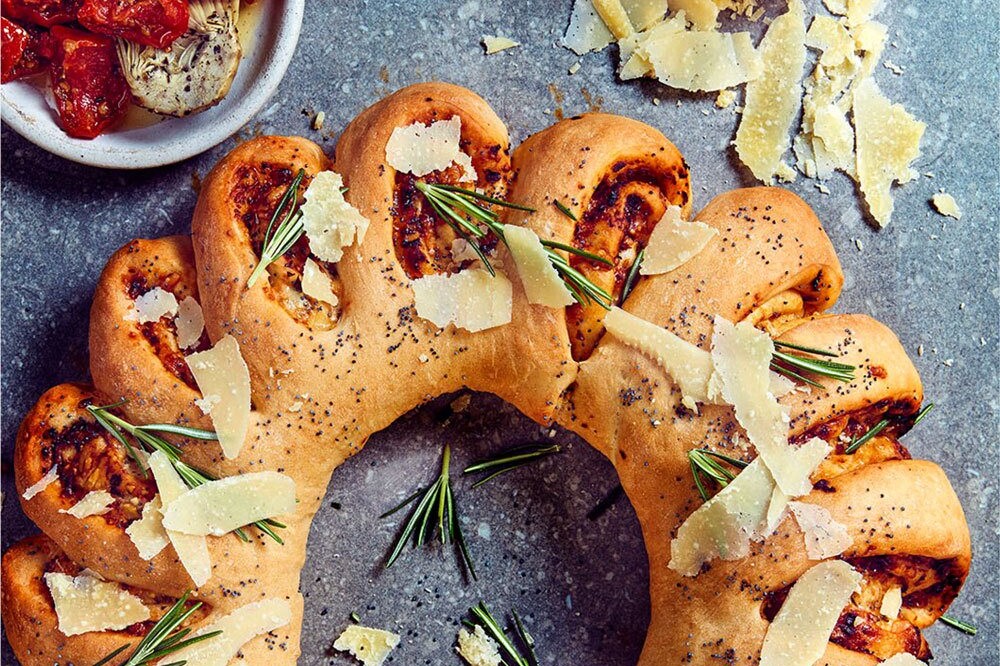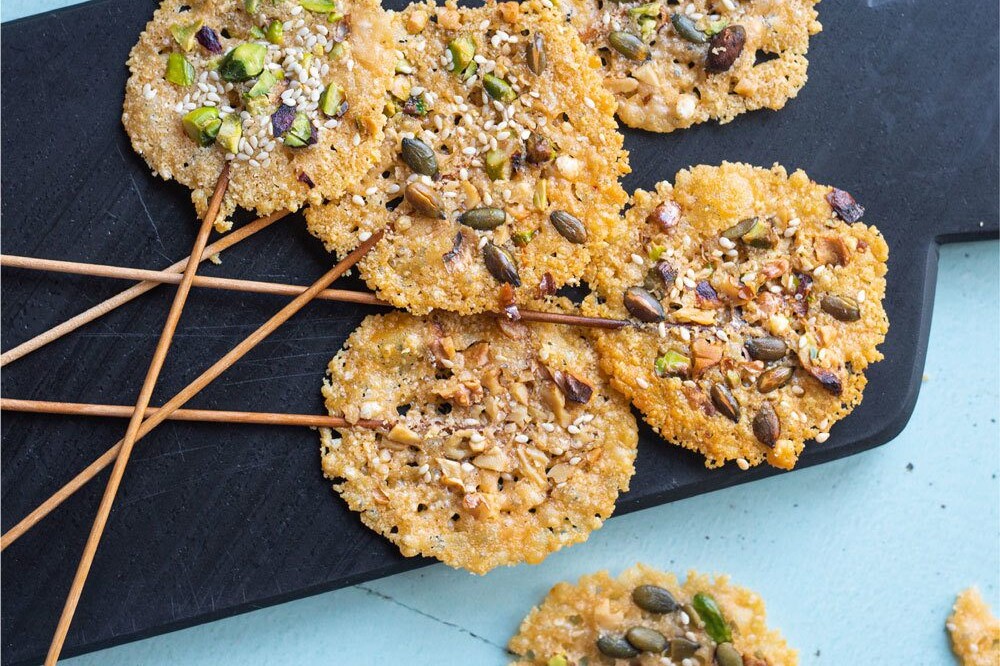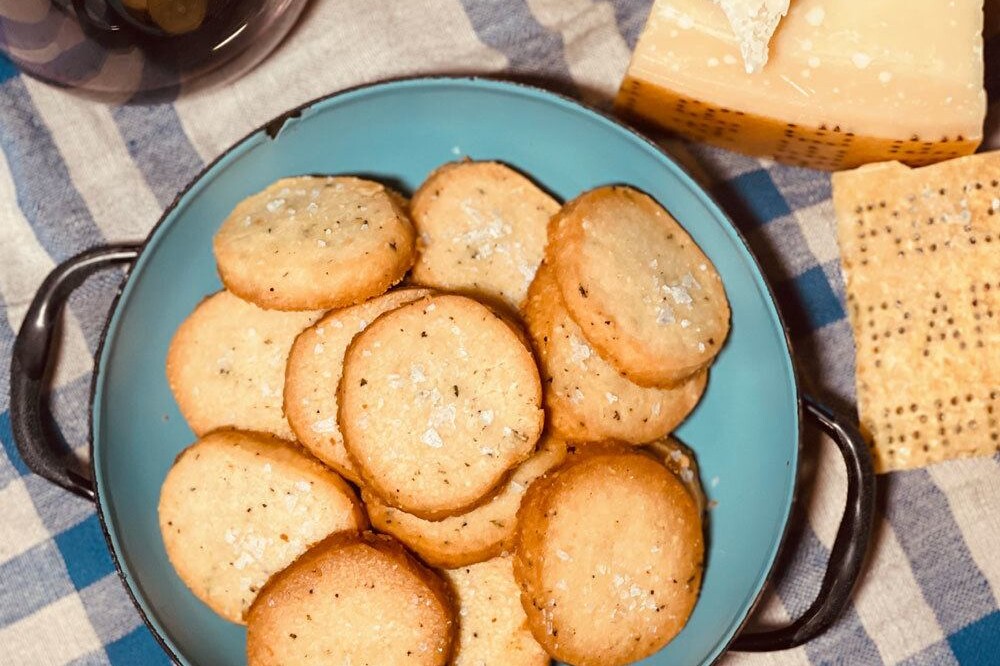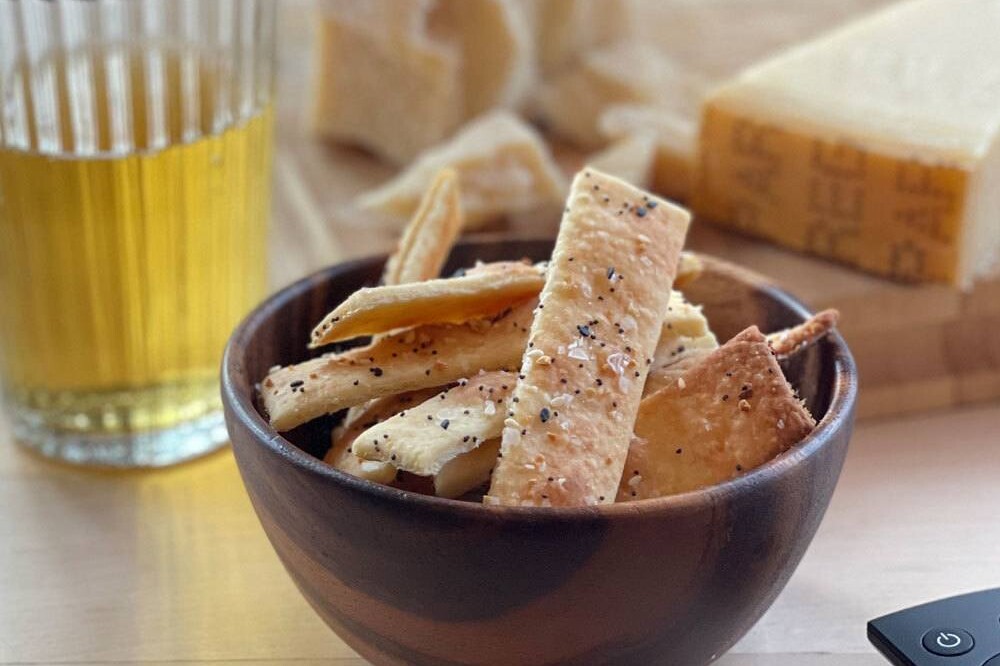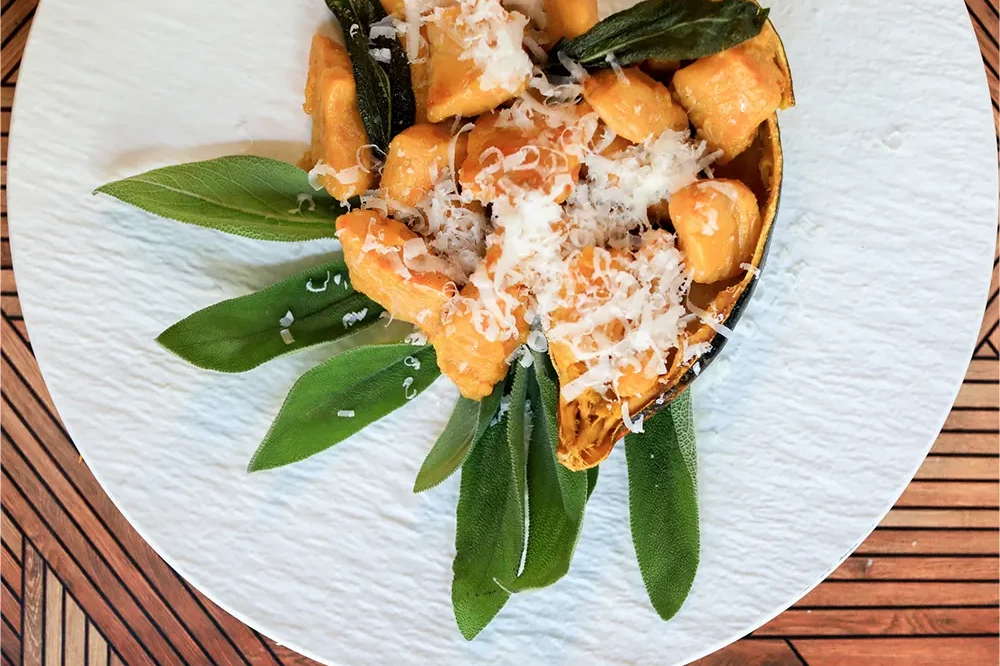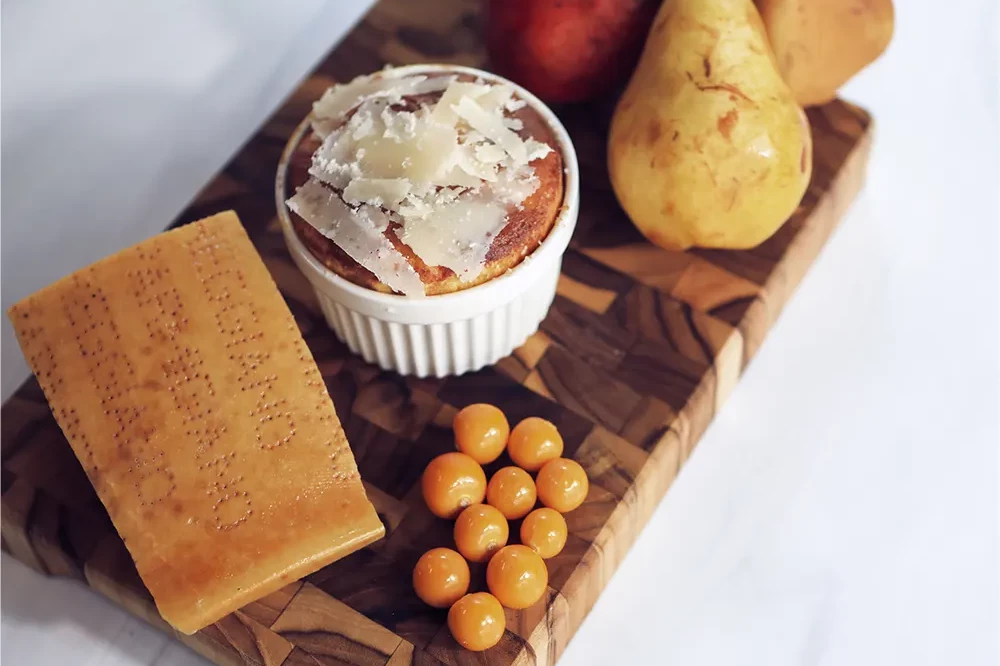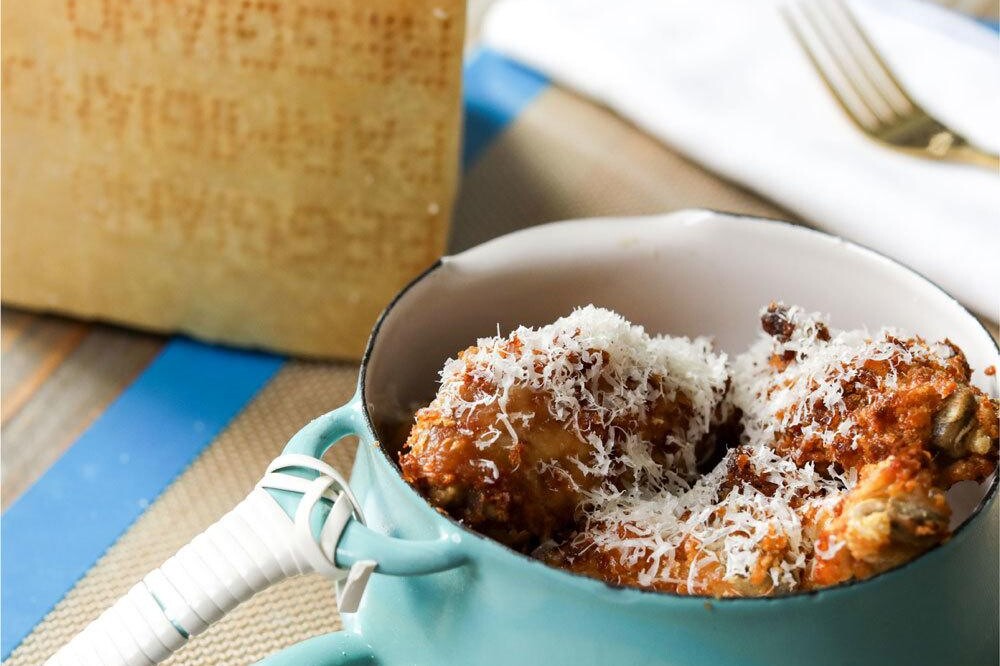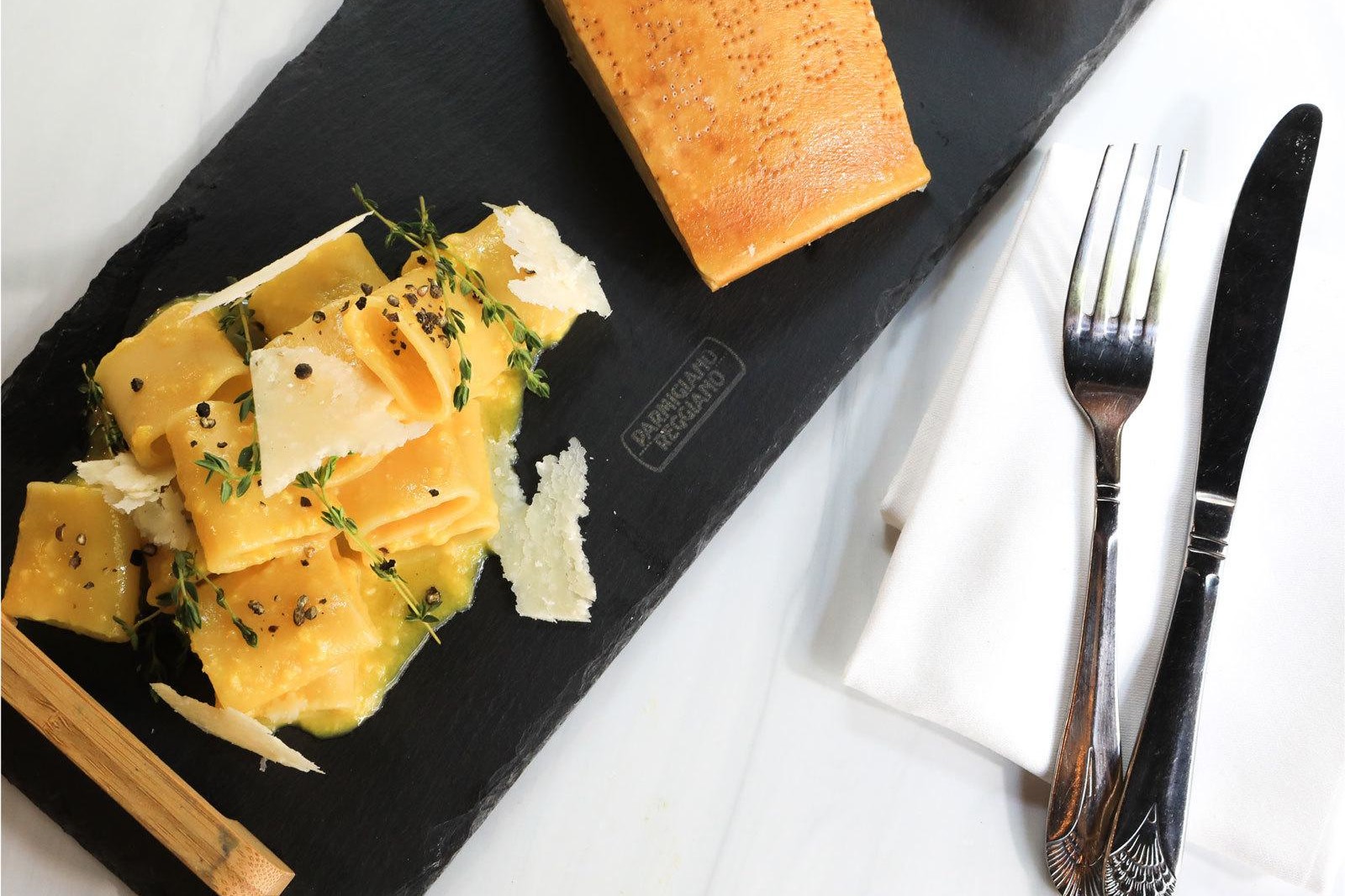Spaghetti alla Bottarga with Parmigiano Reggiano Cheese

Directions:
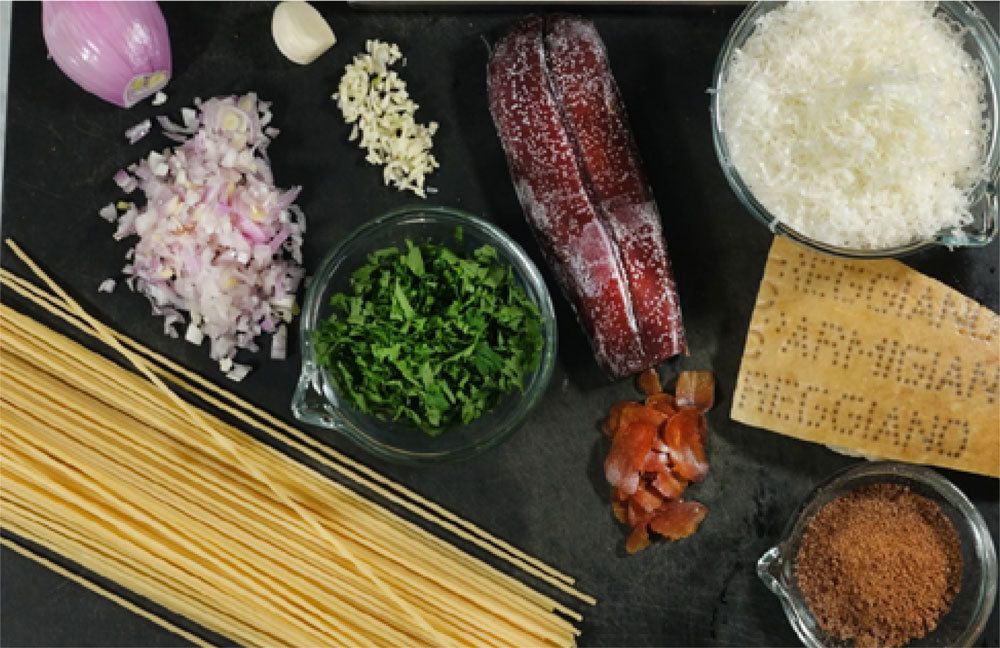
STEP 1
In a large, heavy-bottom pot, bring salted water to a boil and cook the spaghetti according to the package instructions until just al dente.
STEP 2
Meanwhile, in a large skillet or sauté pan, warm the oil over medium low heat. Add the garlic and shallot and let them steep in the oil until they become fragrant, 2 to 3 minutes.
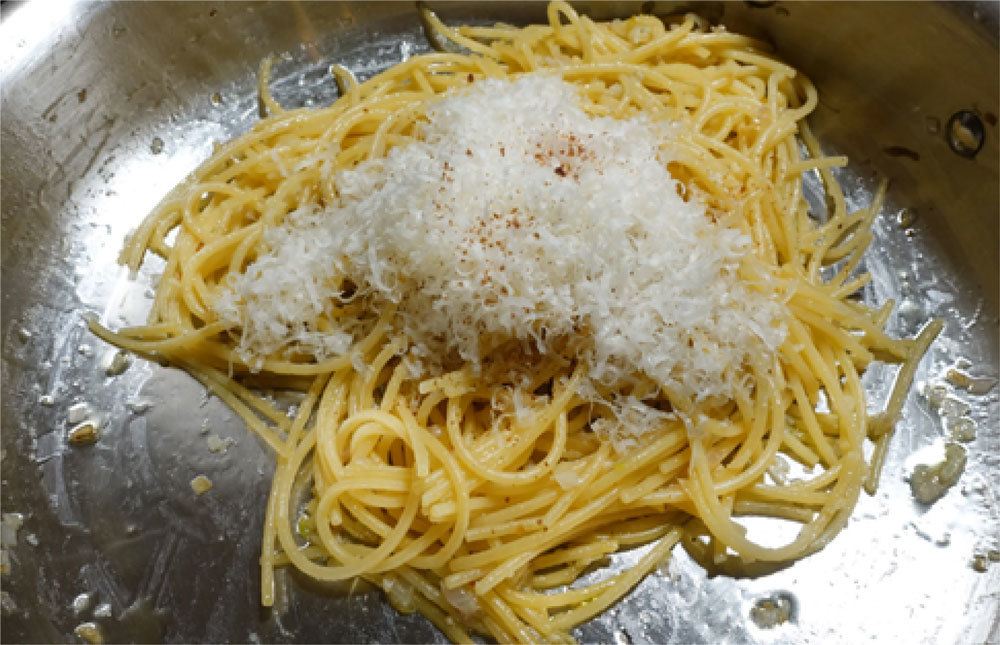
STEP 3
Drain the cooked pasta in a colander keeping a little of the cooking water. Transfer the pasta to the skillet with the warm oil. Add the grated bottarga and the Parmigiano Reggiano cheese. Toss well to combine.
STEP 4
Taste and season if necessary with salt (bearing in mind that bottarga is quite salty). Add the shaved bottarga, parsley and more Parmigiano Reggiano cheese, then serve immediately.

MAIN
Spaghetti alla Bottarga with Parmigiano Reggiano® Cheese
-
10m
PREP
-
20m
COOK
-
350
CALORIES
-
4
SERVINGS
Anthony Bourdain, the colorful TV personality, journalist and author, sadly died in 2018. To celebrate his extraordinary contributions to the industry, the culinary community has since dubbed his birthday Anthony Bourdain Day.
Bourdain’s travels and adventurous eating habits defined food culture for a generation of young chefs who watched him parade through the world, dining on everything from balut (a fertilized egg embryo) to a bodega BEC (bacon egg and cheese). Many chefs called him a friend and mentor. Others who did not know him personally absorbed as much as possible through his books such as “Kitchen Confidential” and watched in awe as he traveled the globe in “Parts Unknown” and
other shows.
In his honor we have recreated our own version of one of his favorites, Spaghetti alla Bottarga.
Bottarga (salted and cured fish roe) is one of those fancy ingredients that you buy at the Italian market and then have no clue what to do with. Rather than let this rare treat go to waste, let’s take a page out of Bourdain’s book and show you the way with a Sardinian dish that’s leaps and bounds easier to make than spaghetti with marinara sauce.
Ingredients:
12 oz spaghetti
1 cup of Parmigiano Reggiano cheese, microplaned
3 tbsp grated bottarga plus more shaved for serving
2 cloves garlic, chopped
1 shallot, chopped
3 tbsp olive oil
Parsley
Look for the seal of authenticity.
For a better experience always use authentic Parmigiano Reggiano, made in Italy.

Hint:
To make sure that you are buying Parmigiano Reggiano cheese, look for the distinctive dotted rind and make sure it is a product of Italy, otherwise it is not Parmigiano Reggiano.
For this recipe we suggest using Parmigiano Reggiano cheese aged 24 months or younger.
We recommend using bottarga from Sardinia, either already grated or you can use a microplane to grate it.
Where to buy:
MAIN
Spaghetti alla Bottarga with Parmigiano Reggiano® Cheese
-
10m
PREP
-
20m
COOK
-
350
CALORIES
-
4
SERVINGS
Anthony Bourdain, the colorful TV personality, journalist and author, sadly died in 2018. To celebrate his extraordinary contributions to the industry, the culinary community has since dubbed his birthday Anthony Bourdain Day.
Bourdain’s travels and adventurous eating habits defined food culture for a generation of young chefs who watched him parade through the world, dining on everything from balut (a fertilized egg embryo) to a bodega BEC (bacon egg and cheese). Many chefs called him a friend and mentor. Others who did not know him personally absorbed as much as possible through his books such as “Kitchen Confidential” and watched in awe as he traveled the globe in “Parts Unknown” and
other shows.
In his honor we have recreated our own version of one of his favorites, Spaghetti alla Bottarga.
Bottarga (salted and cured fish roe) is one of those fancy ingredients that you buy at the Italian market and then have no clue what to do with. Rather than let this rare treat go to waste, let’s take a page out of Bourdain’s book and show you the way with a Sardinian dish that’s leaps and bounds easier to make than spaghetti with marinara sauce.
Directions:

STEP 1
In a large, heavy-bottom pot, bring salted water to a boil and cook the spaghetti according to the package instructions until just al dente.
STEP 2
Meanwhile, in a large skillet or sauté pan, warm the oil over medium low heat. Add the garlic and shallot and let them steep in the oil until they become fragrant, 2 to 3 minutes.

STEP 3
Drain the cooked pasta in a colander keeping a little of the cooking water. Transfer the pasta to the skillet with the warm oil. Add the grated bottarga and the Parmigiano Reggiano cheese. Toss well to combine.
STEP 4
Taste and season if necessary with salt (bearing in mind that bottarga is quite salty). Add the shaved bottarga, parsley and more Parmigiano Reggiano cheese, then serve immediately.

Ingredients:
12 oz spaghetti
1 cup of Parmigiano Reggiano cheese, microplaned
3 tbsp grated bottarga plus more shaved for serving
2 cloves garlic, chopped
1 shallot, chopped
3 tbsp olive oil
Parsley
Look for the seal of authenticity.
For a better experience always use authentic Parmigiano Reggiano, made in Italy.

Hint:
To make sure that you are buying Parmigiano Reggiano cheese, look for the distinctive dotted rind and make sure it is a product of Italy, otherwise it is not Parmigiano Reggiano.
For this recipe we suggest using Parmigiano Reggiano cheese aged 24 months or younger.
We recommend using bottarga from Sardinia, either already grated or you can use a microplane to grate it.
Where to buy:
Complete your meal
SUBMIT YOUR RECIPES
Become a superstar!
Every month our curatorial team will review the recipes that have been submitted. If yours is selected we will send you a nice gift and will feature the recipe on our website (along with your photo and bio), and we’ll also post it on our Social Media platforms.

Four Cheese Eggplant alla Mackie with Parmigiano Reggiano
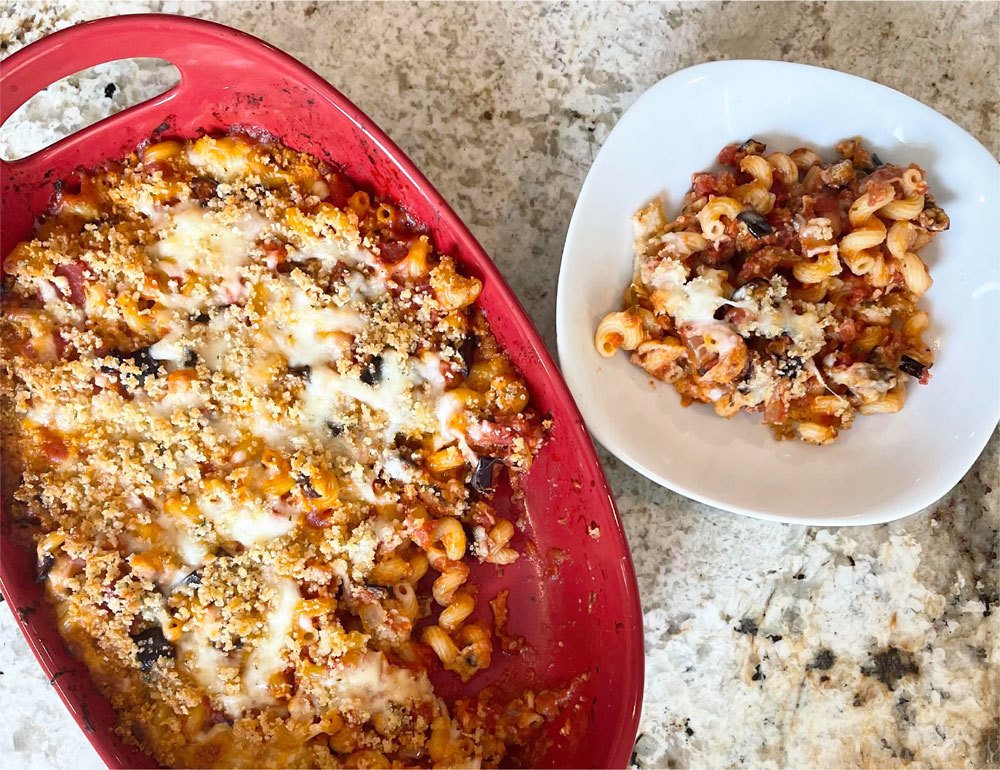
Directions:
STEP 1
Preheat the oven to 350 degrees.
STEP 2
Cube the eggplant. Generously salt the eggplant, and let it sit for about an hour.
STEP 3
Start heating the marinara.
STEP 4
Come back to the eggplant. The eggplant should look almost shiny because the salt drew out some of the moisture. Pat the eggplant well with a paper towel to absorb the water. This process is called “sweating” the eggplant. It helps make the eggplant less soggy.
STEP 5
Spray the eggplant with cooking oil and place batches in the air fryer at 400 degrees for about 10 minutes per batch, flipping about halfway through. Note: If you dont have an air fryer, you can fry it in a pan.
STEP 6
Cook the pasta according to the instructions.
STEP 7
Add the eggplant, mozzarella/provolone blend, and marinara sauce to a baking dish and mix well until everything is evenly distributed.
STEP 8
Heat the butter in the small bowl in the microwave for about 45 seconds or until melted.
STEP 9
Mix the Pecorino Romano, breadcrumbs and melted butter well.
STEP 10
Top the dish with the Parmigiano Reggiano cheese and breadcrumb mixture.
STEP 11
Put in the oven for about 30 minutes or until the breadcrumbs are browned and the dish is bubbling.
STEP 12
Let cool and dig in!
About Mackie

My name is Mackie Ermocida, and I am from the Philadelphia Area. I grew up loving all things food. While I love to experiment with all types of cuisine, my true love is Italian food. The cheeses, the wines, the pastas, the sauces, the flavors – OH MY! I also love traveling to discover new dishes!
Please follow my culinary adventures for more dishes like this.
MAIN
Four Cheese Eggplant alla Mackie with Parmigiano Reggiano® cheese
-
10m
PREP
-
50m
COOK
-
356
CALORIES
-
4
SERVINGS
This recipe was submitted by Mackie Ermocida.
There are several theories about the origin of Eggplant Parmigiana or Parmigiana di Melanzane – as they call it in Italy. Some food writers think the name of the dish derives from Parmigiano Reggiano cheese, the predominant cheese used in the dish – and that is our favorite theory. Others argue that eggplant made its first appearance in in Sicily and the name is derived from the word “palmigiana”, which is the name of the louvered panes of shutters that the layered eggplant slices are meant to resemble. However, most everyone agrees that this is a true classic Italian dish, so delicious that it has become popular around the world.
According to Mackie, “This is one of my favorite recipes! Try it! It is a twist on regular Eggplant Parmigiana. It’s cheesy, it’s saucy, it’s beautiful…and it tastes soooo good!”.
Grazie, Chef Mackie!
Ingredients:
56 oz of Marinara Sauce of your choosing
(I used San Marzano Tomatoes)
3/4 lb cavatappi, fusilli or rotini pasta
1-2 Eggplants, depending on the eggplant to pasta ratio you prefer
1/3 Cup panko breadcrumbs with Italian seasoning
1/4 Cup mozzarella/provolone cheese blend
1/4 Cup Parmigiano Reggiano cheese
1 1/2 Tablespoon butter, unsalted
1 1/2 Teaspoon Pecorino Romano, grated
4 Teaspoons salt
Cooking oil spray
Look for the seal of authenticity.
For a better experience always use authentic Parmigiano Reggiano, made in Italy.

Hint:
To make sure that you are buying Parmigiano Reggiano cheese, look for the distinctive dotted rind and make sure it is a product of Italy, otherwise it is not Parmigiano Reggiano.
Where to buy:
MAIN
Four Cheese Eggplant alla Mackie with Parmigiano Reggiano® cheese
-
10m
PREP
-
50m
COOK
-
356
CALORIES
-
4
SERVINGS
This recipe was submitted by Mackie Ermocida.
There are several theories about the origin of Eggplant Parmigiana or Parmigiana di Melanzane – as they call it in Italy. Some food writers think the name of the dish derives from Parmigiano Reggiano cheese, the predominant cheese used in the dish – and that is our favorite theory. Others argue that eggplant made its first appearance in in Sicily and the name is derived from the word “palmigiana”, which is the name of the louvered panes of shutters that the layered eggplant slices are meant to resemble. However, most everyone agrees that this is a true classic Italian dish, so delicious that it has become popular around the world.
According to Mackie, “This is one of my favorite recipes! Try it! It is a twist on regular Eggplant Parmigiana. It’s cheesy, it’s saucy, it’s beautiful…and it tastes soooo good!”.
Grazie, Chef Mackie!
Directions:
STEP 1
Preheat the oven to 350 degrees.
STEP 2
Cube the eggplant. Generously salt the eggplant, and let it sit for about an hour.
STEP 3
Start heating the marinara.
STEP 4
Come back to the eggplant. The eggplant should look almost shiny because the salt drew out some of the moisture. Pat the eggplant well with a paper towel to absorb the water. This process is called “sweating” the eggplant. It helps make the eggplant less soggy.
STEP 5
Spray the eggplant with cooking oil and place batches in the air fryer at 400 degrees for about 10 minutes per batch, flipping about halfway through. Note: If you dont have an air fryer, you can fry it in a pan.
STEP 6
Cook the pasta according to the instructions.
STEP 7
Add the eggplant, mozzarella/provolone blend, and marinara sauce to a baking dish and mix well until everything is evenly distributed.
STEP 8
Heat the butter in the small bowl in the microwave for about 45 seconds or until melted.
STEP 9
Mix the Pecorino Romano, breadcrumbs and melted butter well.
STEP 10
Top the dish with the Parmigiano Reggiano cheese and breadcrumb mixture.
STEP 11
Put in the oven for about 30 minutes or until the breadcrumbs are browned and the dish is bubbling.
STEP 12
Let cool and dig in!
About Mackie

My name is Mackie Ermocida, and I am from the Philadelphia Area. I grew up loving all things food. While I love to experiment with all types of cuisine, my true love is Italian food. The cheeses, the wines, the pastas, the sauces, the flavors – OH MY! I also love traveling to discover new dishes!
Please follow my culinary adventures for more dishes like this.
Ingredients:
56 oz of Marinara Sauce of your choosing
(I used San Marzano Tomatoes)
3/4 lb cavatappi, fusilli or rotini pasta
1-2 Eggplants, depending on the eggplant to pasta ratio you prefer
1/3 Cup panko breadcrumbs with Italian seasoning
1/4 Cup mozzarella/provolone cheese blend
1/4 Cup Parmigiano Reggiano cheese
1 1/2 Tablespoon butter, unsalted
1 1/2 Teaspoon Pecorino Romano, grated
4 Teaspoons salt
Cooking oil spray
Look for the seal of authenticity.
For a better experience always use authentic Parmigiano Reggiano, made in Italy.

Hint:
To make sure that you are buying Parmigiano Reggiano cheese, look for the distinctive dotted rind and make sure it is a product of Italy, otherwise it is not Parmigiano Reggiano.
Where to buy:
Complete your meal
SUBMIT YOUR RECIPES
Become a superstar!
Every month our curatorial team will review the recipes that have been submitted. If yours is selected we will send you a nice gift and will feature the recipe on our website (along with your photo and bio), and we’ll also post it on our Social Media platforms.

Black Truffle Pasta & Parmigiano Reggiano cheese

Directions:
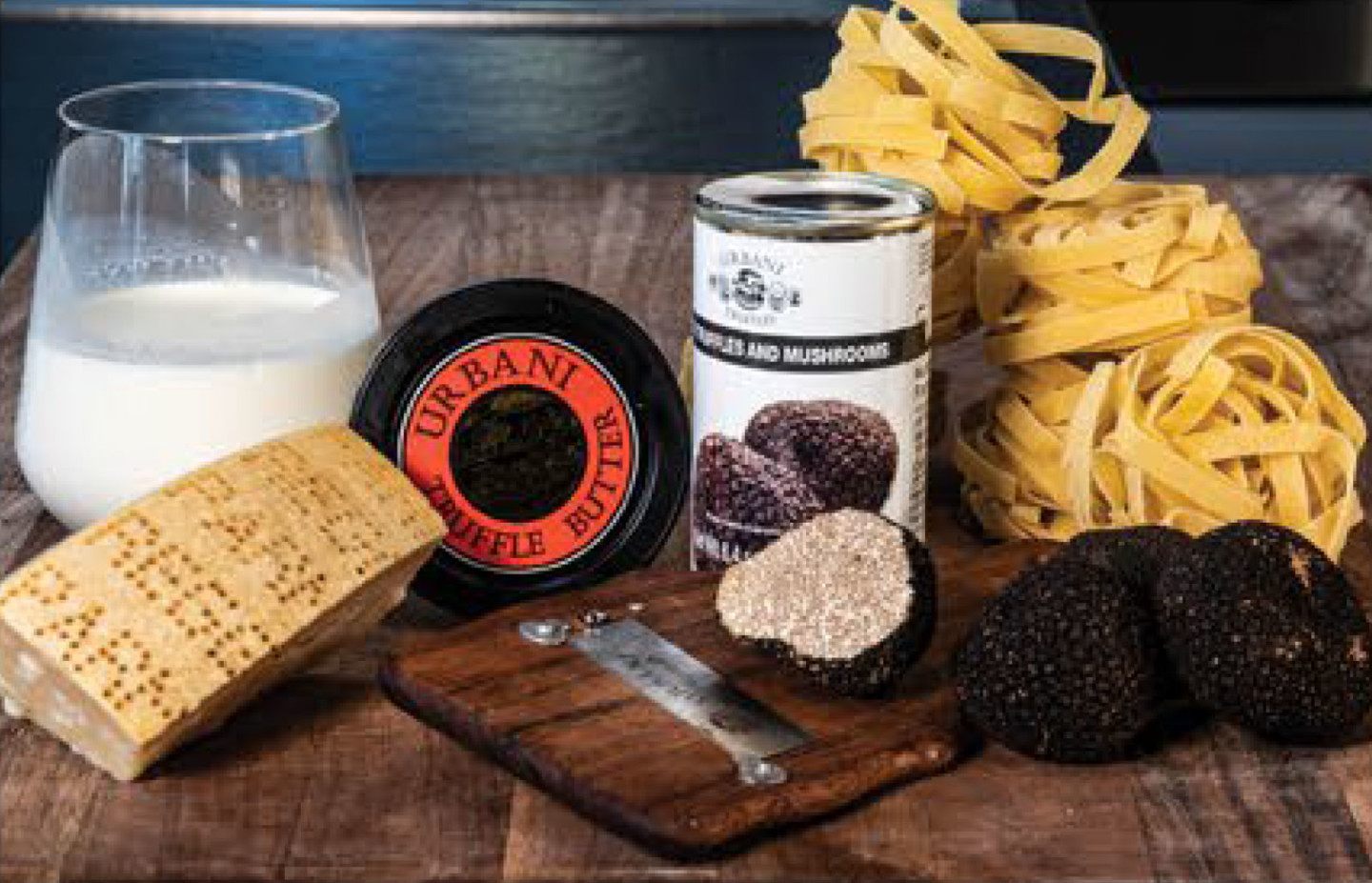
STEP 1
Place the room temperature Urbani Black Truffle Butter in a small mixing bowl.
Add milk and whisk the mixture for 3 minutes to create a buttery sauce.
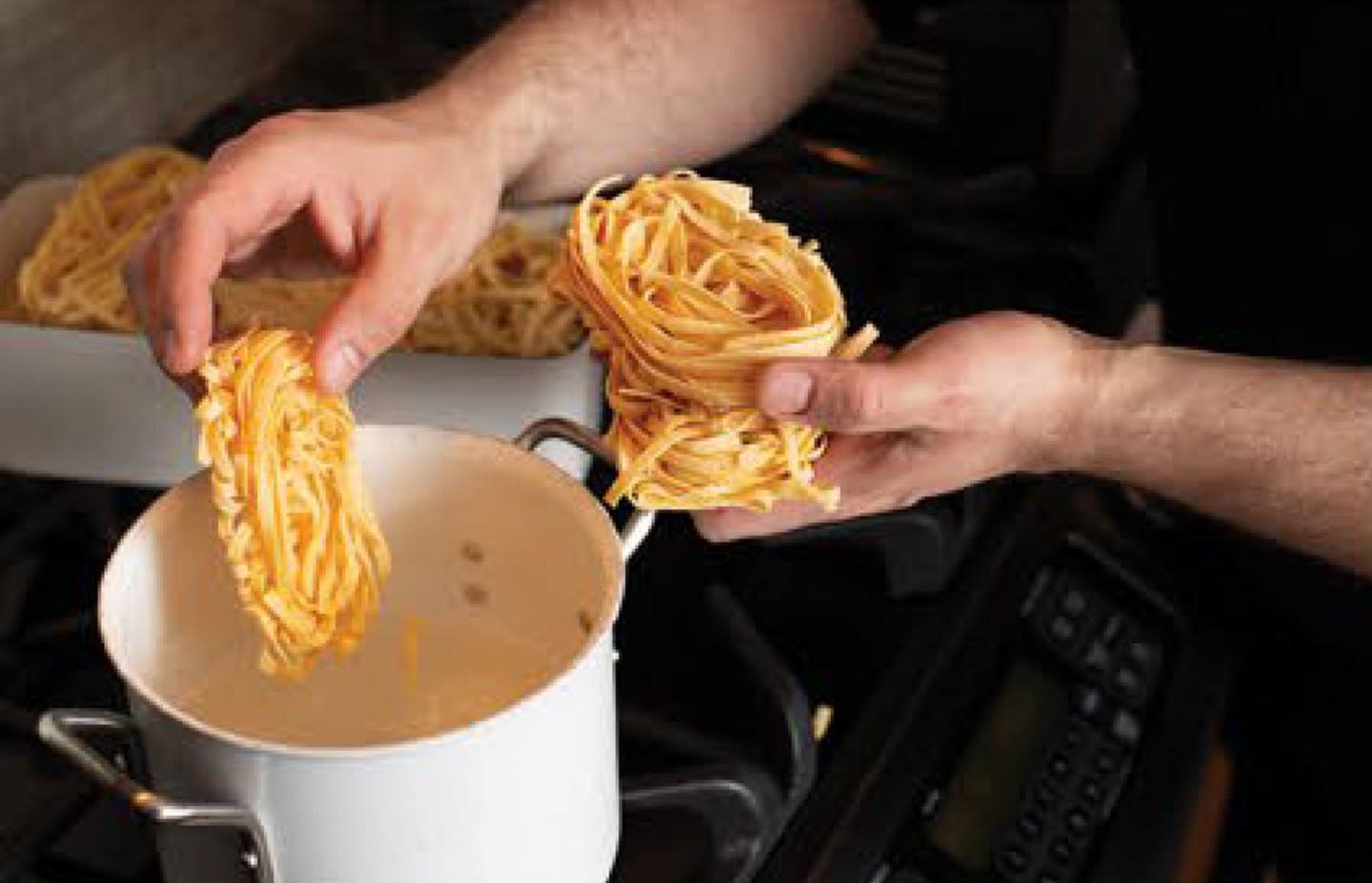
STEP 2
Bring 4 – 6 quarts of water to a rolling boil in a large pot and add a pinch of salt.
Add fettuccine to boiling water. Stir gently.
STEP 3
Return water to a boil. For authentic “al dente” pasta, boil uncovered – stirring occasionally for 12 minutes. Towards the end of the cooking time, take a couple of ladles of the pasta cooking water and set it aside (you may need it later).
Remove the fettuccine from heat. Drain well.
STEP 4
Pour the sauce in a ceramic bowl, add Parmigiano Reggiano cheese and Urbani Black Truffle Thrill and stir gently. If the sauce seems too thick add a little of the pasta water that was set aside earlier, until you arrive at a smooth creamy texture. Add the pasta to the bowl mixing it with the sauce.

STEP 5
Finally, serve the pasta on a dish, add a little more freshly grated Parmigiano Reggiano cheese and a shave a few thin slices of Urbani Summer Black Truffles on top. You are now ready to enjoy a dish that will transport you to the heart of Italy. Buon Appetito!
MAIN
Black Truffle Pasta &
Parmigiano Reggiano cheese
-
15m
PREP
-
10m
COOK
-
370
CALORIES
-
4
SERVINGS
This pasta recipe is the perfect treat for dinner with the one you love. The earthy rich flavor of Urbani’s Summer Black Truffles combined with the distinctive taste and texture of Parmigiano Reggiano cheese makes this recipe a decadent and delicious treat for your palate. Plus it is easy to make, takes no time at all, and requires just a few (but very good) ingredients!!
Ingredients:
1 oz fresh Urbani Summer Black Truffles
4 tablespoons Urbani Black Truffle Thrill
1/4 cup Urbani Black Truffle Butter
2 tablespoons organic whole milk
9 oz pasta (fettuccine)
1/4 teaspoon salt
1/4 cup freshly grated Parmigiano Reggiano cheese
Look for the seal of authenticity.
For a better experience always use authentic Parmigiano Reggiano, made in Italy.

Hint:
Chef Michele suggests using Parmigiano Reggiano cheese aged at least 24 months.
Where to buy:
MAIN
Black Truffle Pasta &
Parmigiano Reggiano cheese
-
15m
PREP
-
10m
COOK
-
370
CALORIES
-
4
SERVINGS
This pasta recipe is the perfect treat for dinner with the one you love. The earthy rich flavor of Urbani’s Summer Black Truffles combined with the distinctive taste and texture of Parmigiano Reggiano cheese makes this recipe a decadent and delicious treat for your palate. Plus it is easy to make, takes no time at all, and requires just a few (but very good) ingredients!!
Directions:

STEP 1
Place the room temperature Urbani Black Truffle Butter in a small mixing bowl.
Add milk and whisk the mixture for 3 minutes to create a buttery sauce.

STEP 2
Bring 4 – 6 quarts of water to a rolling boil in a large pot and add a pinch of salt.
Add fettuccine to boiling water. Stir gently.
STEP 3
Return water to a boil. For authentic “al dente” pasta, boil uncovered – stirring occasionally for 12 minutes. Towards the end of the cooking time, take a couple of ladles of the pasta cooking water and set it aside (you may need it later).
Remove the fettuccine from heat. Drain well.
STEP 4
Pour the sauce in a ceramic bowl, add Parmigiano Reggiano cheese and Urbani Black Truffle Thrill and stir gently. If the sauce seems too thick add a little of the pasta water that was set aside earlier, until you arrive at a smooth creamy texture. Add the pasta to the bowl mixing it with the sauce.

STEP 5
Finally, serve the pasta on a dish, add a little more freshly grated Parmigiano Reggiano cheese and a shave a few thin slices of Urbani Summer Black Truffles on top. You are now ready to enjoy a dish that will transport you to the heart of Italy. Buon Appetito!
Ingredients:
1 oz fresh Urbani Summer Black Truffles
4 tablespoons Urbani Black Truffle Thrill
1/4 cup Urbani Black Truffle Butter
2 tablespoons organic whole milk
9 oz pasta (fettuccine)
1/4 teaspoon salt
1/4 cup freshly grated Parmigiano Reggiano cheese
Look for the seal of authenticity.
For a better experience always use authentic Parmigiano Reggiano, made in Italy.

Hint:
Chef Michele suggests using Parmigiano Reggiano cheese aged at least 24 months.
Where to buy:
Complete your meal
SUBMIT YOUR RECIPES
Become a superstar!
Every month our curatorial team will review the recipes that have been submitted. If yours is selected we will send you a nice gift and will feature the recipe on our website (along with your photo and bio), and we’ll also post it on our Social Media platforms.

Vegetable ‘Quesadina’ with Parmigiano Reggiano cheese
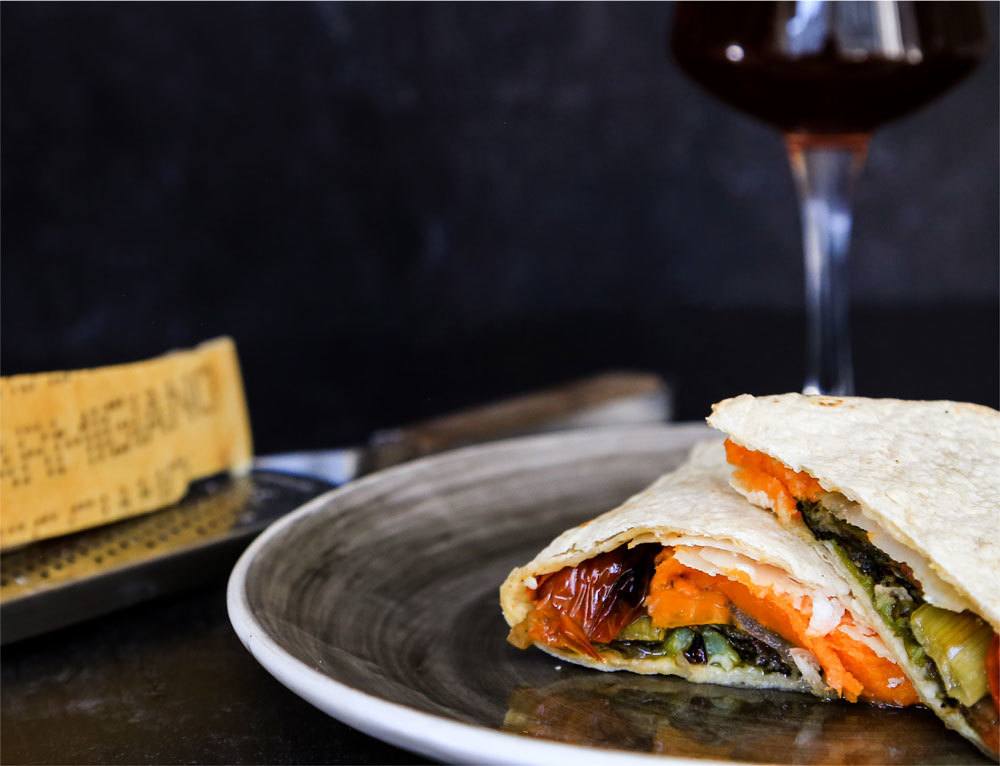
Directions:
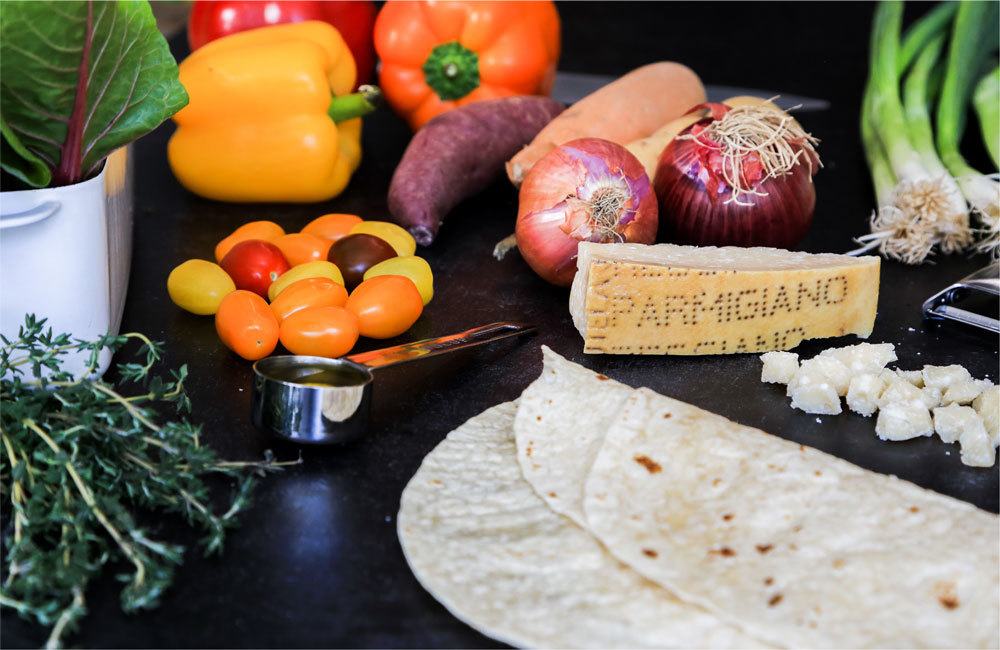
STEP 1
Set your oven temperature to 375 F. A high temperature allows for the great color and texture of the vegetables, without drying the them out.
STEP 2
While the oven is preheating, line a baking sheet with parchment or foil. Toss the vegetables with the oil and spices using your hands ensuring they are completely coated. Place the vegetables onto the baking sheet.

STEP 3
Bake the vegetables for 35 minutes. Stirring halfway through so they can crisp on both sides. Once done, remove from oven and let rest for 10 minutes.
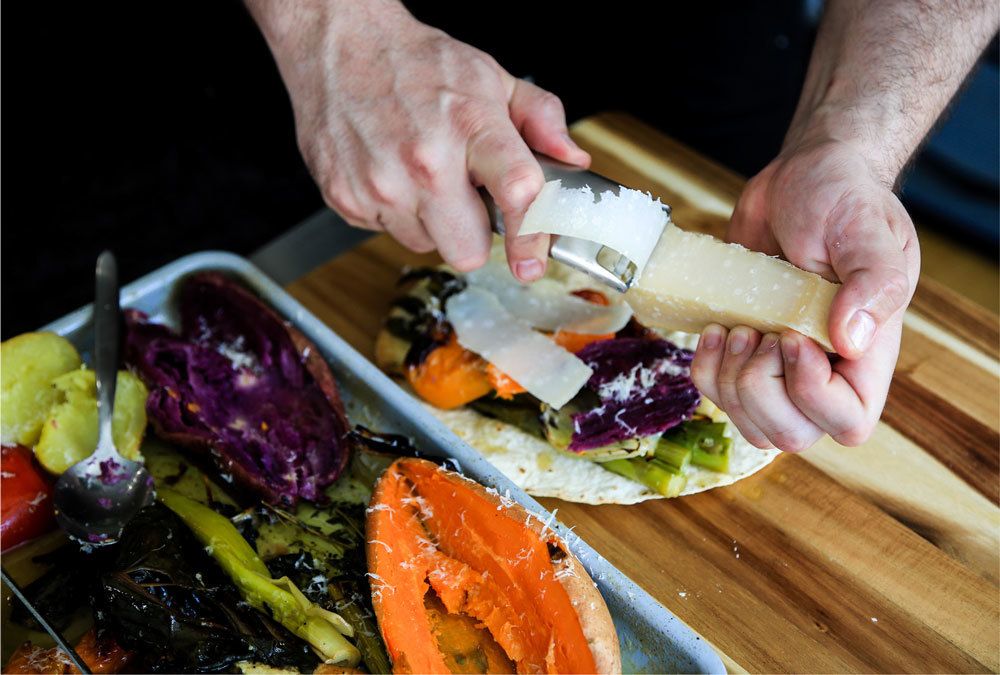
STEP 4
Once vegetables have rested chop to desired thickness and place in tortilla. Shave the Parmigiano Reggiano cheese onto the vegetables. Fold the tortilla and enjoy the Quesadina as is or, place the Quesadina in a skillet to crisp up the outside of the tortilla and to soften the Parmigiano Reggiano cheese. Enjoy alone or with your favorite toppings!
MAIN
Vegetable ‘Quesadina’ with Parmigiano Reggiano® cheese
-
10m
PREP
-
35m
COOK
-
250
CALORIES
-
4
SERVINGS
Literally meaning ‘little cheesy thing’, quesadillas originated in colonial Mexico in the 16th century.
Today, the dish consists of a tortilla filled primarily with Oaxaca cheese, and then cooked on a comal, which is a smooth, flat griddle used to cook tortillas and arepas.
Piadina is a rustic Italian flatbread typical of the Romagna region in Italy. It is prepared with dough cooked fresh on a griddle and filled with a variety of meats, cheeses, and vegetables.
In Italy there is a saying that goes: “Don’t call it piadina if it’s not made in Romagna.” The people of Romagna are so proud of their local specialty of piadina that they applied for and obtained PGI (Protected Geographical Application) for its two versions in 2014: the so-called Piadina Terre di Romagna and the Piadina Romagnola di Rimini.
Chef Michele Cassadei Massari has combined these two dishes to create the ‘Quesadina’ using loads of veggies and Parmigiano Reggiano cheese. It’s a great opportunity to use leftover vegetables. And, is a great option for a snack, an appetizers or even dinner.
Ingredients:
2 pounds any vegetables, cut in large chunks (onions, peppers, tomatos, yams, swiss chard, asparagus, fresh herbs, etc.)
1 tablespoon olive oil
1 teaspoon salt
1/4 teaspoon freshly ground black pepper
1 large Parmigiano Reggiano rind
1 cup Parmigiano Reggiano cheese, shaved
4 tortillas
Balsamic reduction, to drizzle, and/or your favorite toppings
Look for the seal of authenticity.
For a better experience always use authentic Parmigiano Reggiano, made in Italy.

Hint:
Chef Michele suggests using a mixture of Parmigiano Reggiano cheese aged 16 months and 24 months if you can find both. The younger cheese melts nicely while the older cheese will give more flavor.
Where to buy:
MAIN
Vegetable ‘Quesadina’ with Parmigiano Reggiano® cheese
-
10m
PREP
-
35m
COOK
-
250
CALORIES
-
4
SERVINGS
Literally meaning ‘little cheesy thing’, quesadillas originated in colonial Mexico in the 16th century.
Today, the dish consists of a tortilla filled primarily with Oaxaca cheese, and then cooked on a comal, which is a smooth, flat griddle used to cook tortillas and arepas.
Piadina is a rustic Italian flatbread typical of the Romagna region in Italy. It is prepared with dough cooked fresh on a griddle and filled with a variety of meats, cheeses, and vegetables.
In Italy there is a saying that goes: “Don’t call it piadina if it’s not made in Romagna.” The people of Romagna are so proud of their local specialty of piadina that they applied for and obtained PGI (Protected Geographical Application) for its two versions in 2014: the so-called Piadina Terre di Romagna and the Piadina Romagnola di Rimini.
Chef Michele Cassadei Massari has combined these two dishes to create the ‘Quesadina’ using loads of veggies and Parmigiano Reggiano cheese. It’s a great opportunity to use leftover vegetables. And, is a great option for a snack, an appetizers or even dinner.
Directions:

STEP 1
Set your oven temperature to 375 F. A high temperature allows for the great color and texture of the vegetables, without drying the them out.
STEP 2
While the oven is preheating, line a baking sheet with parchment or foil. Toss the vegetables with the oil and spices using your hands ensuring they are completely coated. Place the vegetables onto the baking sheet.

STEP 3
Bake the vegetables for 35 minutes. Stirring halfway through so they can crisp on both sides. Once done, remove from oven and let rest for 10 minutes.

STEP 4
Once vegetables have rested chop to desired thickness and place in tortilla. Shave the Parmigiano Reggiano cheese onto the vegetables. Fold the tortilla and enjoy the Quesadina as is or, place the Quesadina in a skillet to crisp up the outside of the tortilla and to soften the Parmigiano Reggiano cheese. Enjoy alone or with your favorite toppings!
Ingredients:
2 pounds any vegetables, cut in large chunks (onions, peppers, tomatos, yams, swiss chard, asparagus, fresh herbs, etc.)
1 tablespoon olive oil
1 teaspoon salt
1/4 teaspoon freshly ground black pepper
1 large Parmigiano Reggiano rind
1 cup Parmigiano Reggiano cheese, shaved
4 tortillas
Balsamic reduction, to drizzle, and/or your favorite toppings
Look for the seal of authenticity.
For a better experience always use authentic Parmigiano Reggiano, made in Italy.

Hint:
Chef Michele suggests using a mixture of Parmigiano Reggiano cheese aged 16 months and 24 months if you can find both. The younger cheese melts nicely while the older cheese will give more flavor.
Where to buy:
Complete your meal
SUBMIT YOUR RECIPES
Become a superstar!
Every month our curatorial team will review the recipes that have been submitted. If yours is selected we will send you a nice gift and will feature the recipe on our website (along with your photo and bio), and we’ll also post it on our Social Media platforms.

Three Step Pasta alla Carbonara with Parmigiano Reggiano cheese
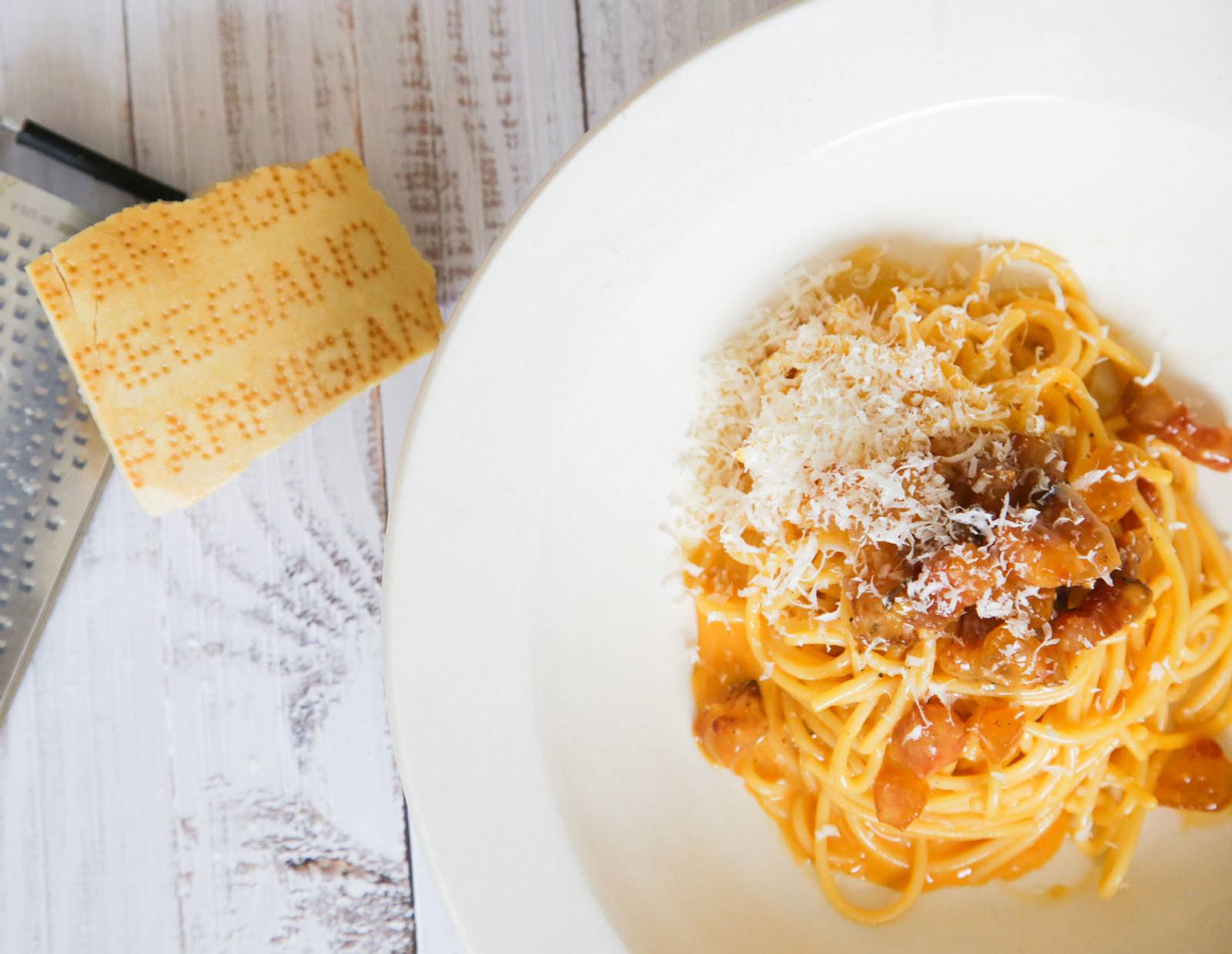
Directions:
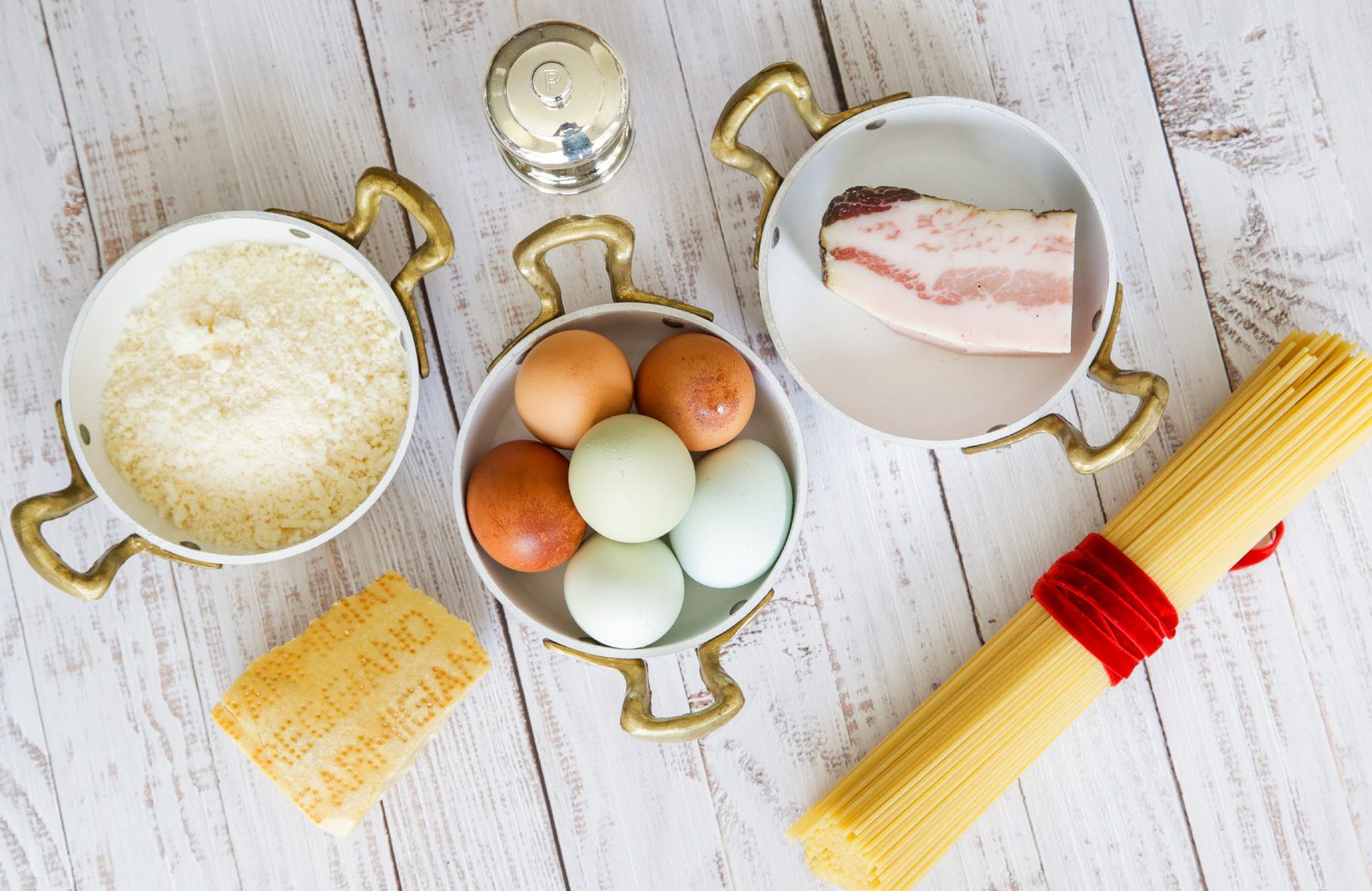
STEP 1
Bring 4 quarts of water to a boil. Once boiling add 1 tablespoon salt and let dissolve. Add the pasta to the pot to cook it, but make sure that the pasta is a little firmer than al dente. (You will be putting the pasta over heat again and you don’t want them to get mushy. Set aside about a cup of the pasta water before straining it. While pasta is cooking, brown the guanciale in a non-stick pan over medium heat. Once browned turn off heat and set aside.

STEP 2
In a stainless steel bowl whisk the yolks and about 80% of the grated Parmigiano Reggiano cheese needed for the recipe. The remaining cheese will be sprinkled on the pasta right before serving.
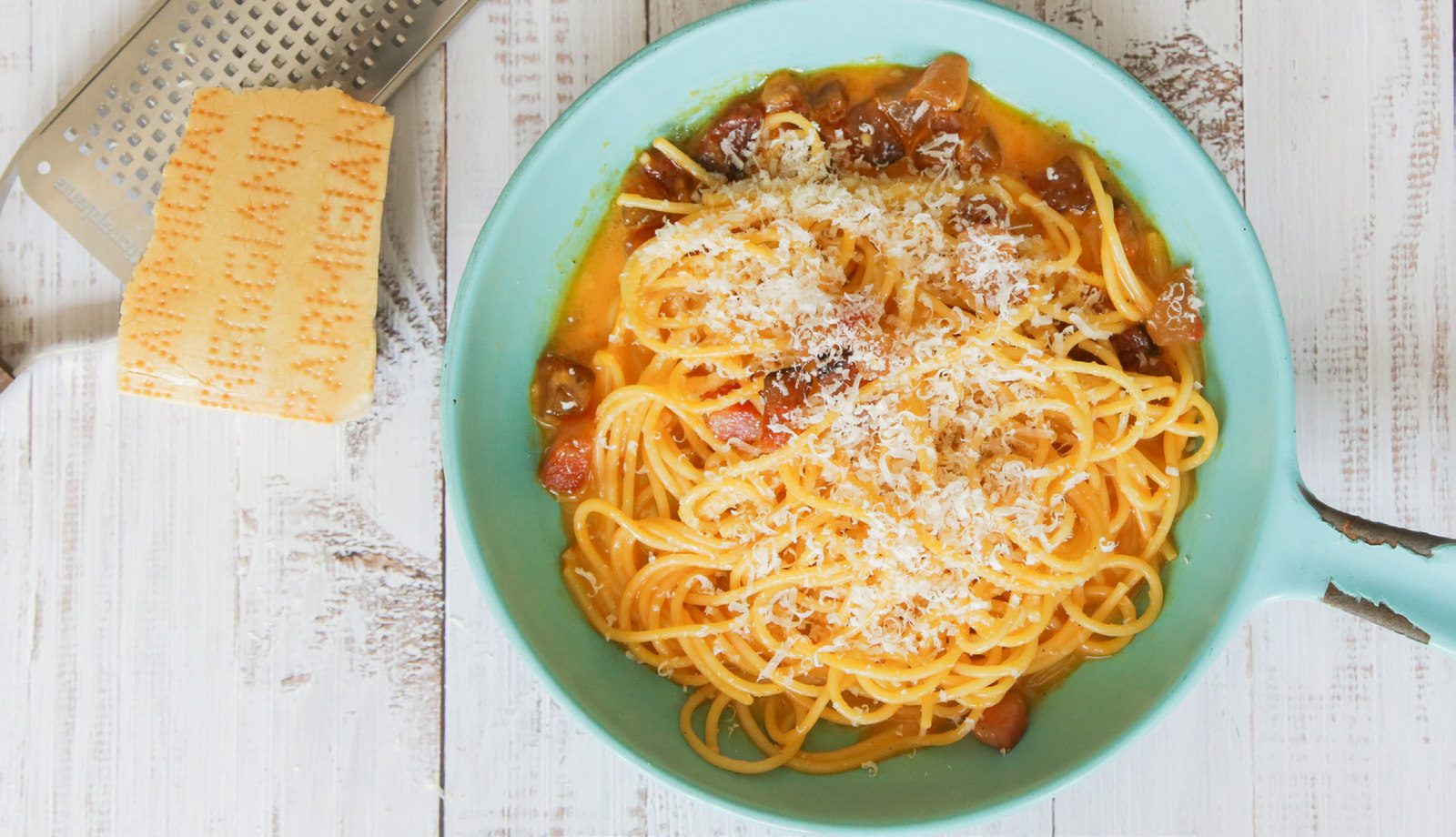
STEP 3
Return the pan with guanciale to a burner on low heat. Add 2 tablespoon of the yolk mixture and 1 spoon of cooking water. Stir well, for about 3 minutes, turn off the burner, add the pasta directly into the pan and then add the rest of the yolk mixture stirring quickly and vigorously to combine. If it seems dry add some of the pasta water that you had set aside. Sprinkle the rest of the Parmigiano Reggiano cheese and some black pepper – and get ready to enjoy one of Italy’s most famous pastas.
MAIN
Three Step Pasta alla Carbonara with Parmigiano Reggiano® cheese
-
15m
PREP
-
10m
COOK
-
345
CALORIES
-
4
SERVINGS
One of Italy’s most beloved dishes, Pasta alla Carbonara is a rich and decadent dish made with egg yolks, hard seasoned cheese, guanciale (gwaan·chaa·lei) and black pepper. Guanciale is an Italian cured meat product prepared from pork jowl or cheeks – whose name is derived from ‘guancia’, the Italian word for ‘cheek’.
Many traditional carbonara recipes call for Pecorino Romano cheese, but Parmigiano Reggiano is also often used, as well as a combination of the two.
The origin of the dish is a source of much debate, and you can read a little about the various origin stories in an article our blog.
Here we present Chef Michele Casadei Massari’s special version, which can be made quickly in three simple steps, and uses only Parmigiano Reggiano cheese, because according to Chef Michele, “it’s the most soluble hard cheese ever; hence an amazing fit for this recipe”. He also prefers to make it with duck eggs because they add a bit of extra flavor and color to the dish.
Ingredients:
6 egg yolks
5 oz guanciale, cut into ½ inch pieces (bacon can work as well if you can’t find guanciale)
1lb spaghetti
½ cup Parmigiano Reggiano cheese (see HINT )
Fresh ground black pepper
Look for the seal of authenticity.
For a better experience always use authentic Parmigiano Reggiano, made in Italy.

Hint:
Chef Michele’s suggests using duck eggs for a bit more flavor and color.
We suggest Parmigiano Reggiano cheese aged 24 months. Cheese that has been aged longer won’t melt as nicely.
Where to buy:
MAIN
Three Step Pasta alla Carbonara with Parmigiano Reggiano® cheese
-
15m
PREP
-
10m
COOK
-
345
CALORIES
-
4
SERVINGS
One of Italy’s most beloved dishes, Pasta alla Carbonara is a rich and decadent dish made with egg yolks, hard seasoned cheese, guanciale (gwaan·chaa·lei) and black pepper. Guanciale is an Italian cured meat product prepared from pork jowl or cheeks – whose name is derived from ‘guancia’, the Italian word for ‘cheek’.
Many traditional carbonara recipes call for Pecorino Romano cheese, but Parmigiano Reggiano is also often used, as well as a combination of the two.
The origin of the dish is a source of much debate, and you can read a little about the various origin stories in an article our blog.
Here we present Chef Michele Casadei Massari’s special version, which can be made quickly in three simple steps, and uses only Parmigiano Reggiano cheese, because according to Chef Michele, “it’s the most soluble hard cheese ever; hence an amazing fit for this recipe”. He also prefers to make it with duck eggs because they add a bit of extra flavor and color to the dish.
Directions:

STEP 1
Bring 4 quarts of water to a boil. Once boiling add 1 tablespoon salt and let dissolve. Add the pasta to the pot to cook it, but make sure that the pasta is a little firmer than al dente. (You will be putting the pasta over heat again and you don’t want them to get mushy. Set aside about a cup of the pasta water before straining it. While pasta is cooking, brown the guanciale in a non-stick pan over medium heat. Once browned turn off heat and set aside.

STEP 2
In a stainless steel bowl whisk the yolks and about 80% of the grated Parmigiano Reggiano cheese needed for the recipe. The remaining cheese will be sprinkled on the pasta right before serving.

STEP 3
Return the pan with guanciale to a burner on low heat. Add 2 tablespoon of the yolk mixture and 1 spoon of cooking water. Stir well, for about 3 minutes, turn off the burner, add the pasta directly into the pan and then add the rest of the yolk mixture stirring quickly and vigorously to combine. If it seems dry add some of the pasta water that you had set aside. Sprinkle the rest of the Parmigiano Reggiano cheese and some black pepper – and get ready to enjoy one of Italy’s most famous pastas.
Ingredients:
6 egg yolks
5 oz guanciale, cut into ½ inch pieces (bacon can work as well if you can’t find guanciale)
1lb spaghetti
½ cup Parmigiano Reggiano cheese (see HINT )
Fresh ground black pepper
Look for the seal of authenticity.
For a better experience always use authentic Parmigiano Reggiano, made in Italy.

Hint:
Chef Michele’s suggests using duck eggs for a bit more flavor and color.
We suggest Parmigiano Reggiano cheese aged 24 months. Cheese that has been aged longer won’t melt as nicely.
Where to buy:
SUBMIT YOUR RECIPES
Become a superstar!
Every month our curatorial team will review the recipes that have been submitted. If yours is selected we will send you a nice gift and will feature the recipe on our website (along with your photo and bio), and we’ll also post it on our Social Media platforms.

Italian Dumplings with Artichokes and Leeks
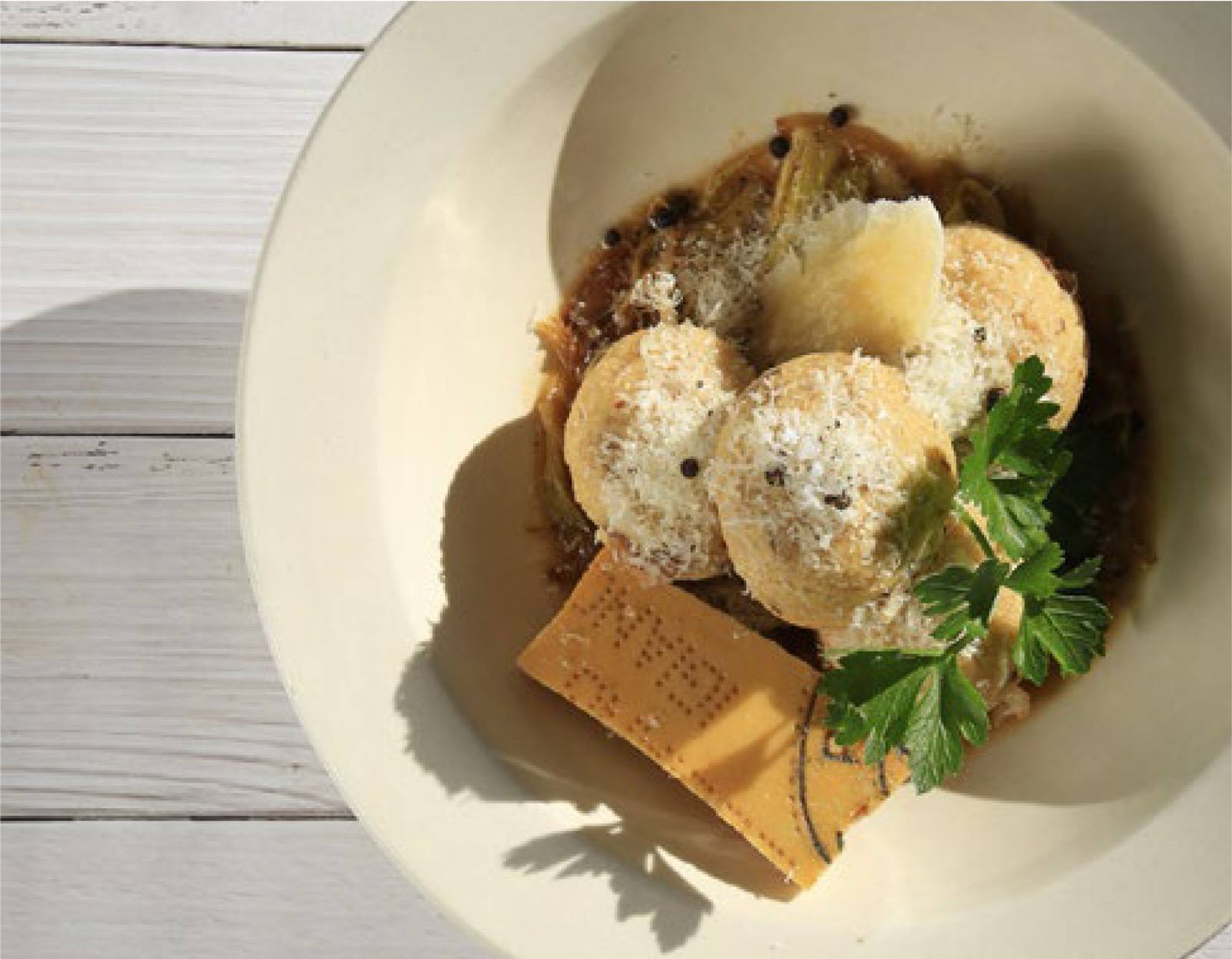
Directions:
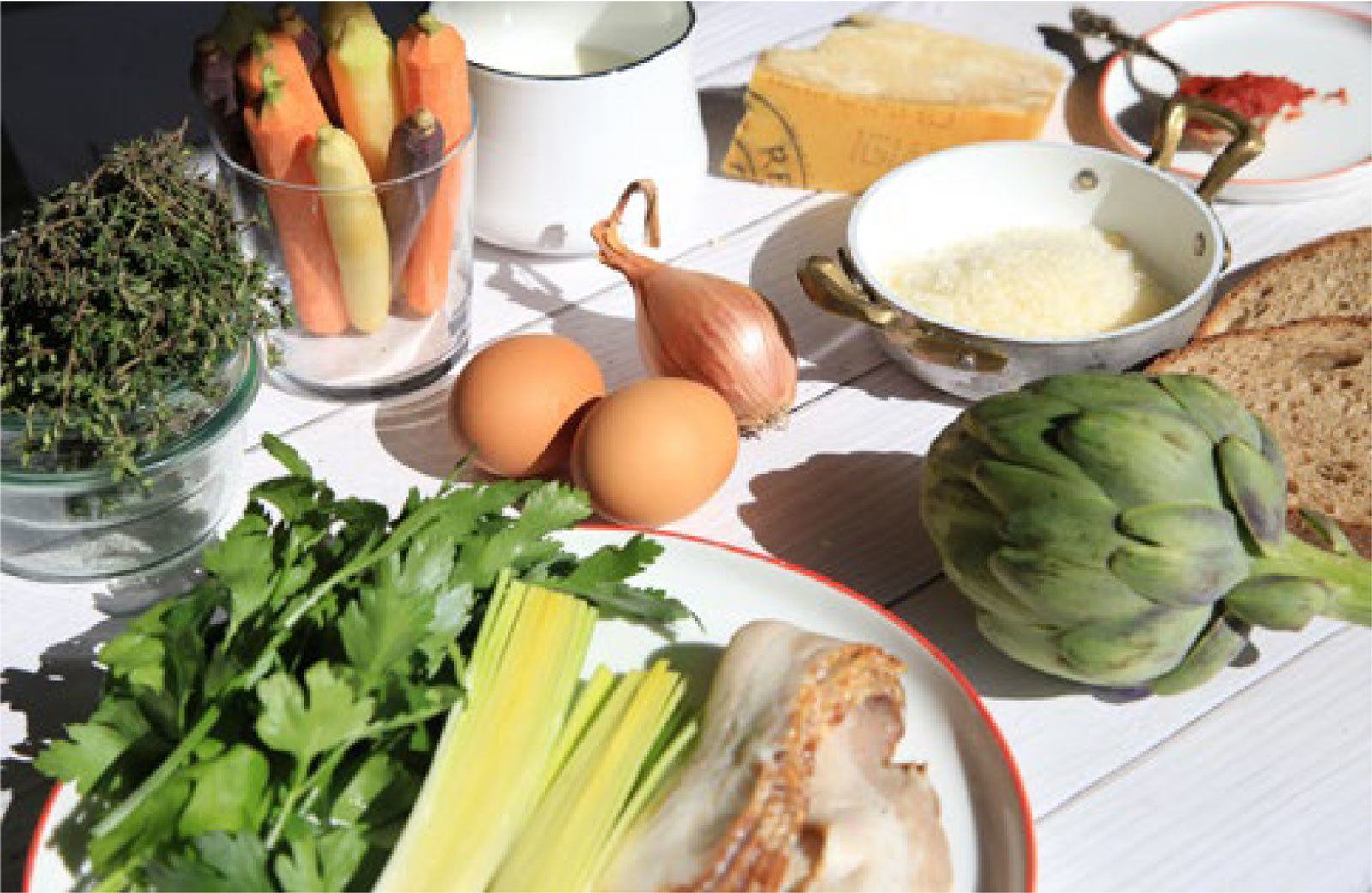
STEP 1
Place the bread in a bowl. Lightly beat the egg with the milk. Add it to the bread and mix well. Allow to soak for at least 25 minutes.

STEP 2
While the bread is soaking prepare the broth. Boil the vegetables in 2 quarts of water for 30 minutes, add salt at the end to taste. Strain the broth and return back to the pot.
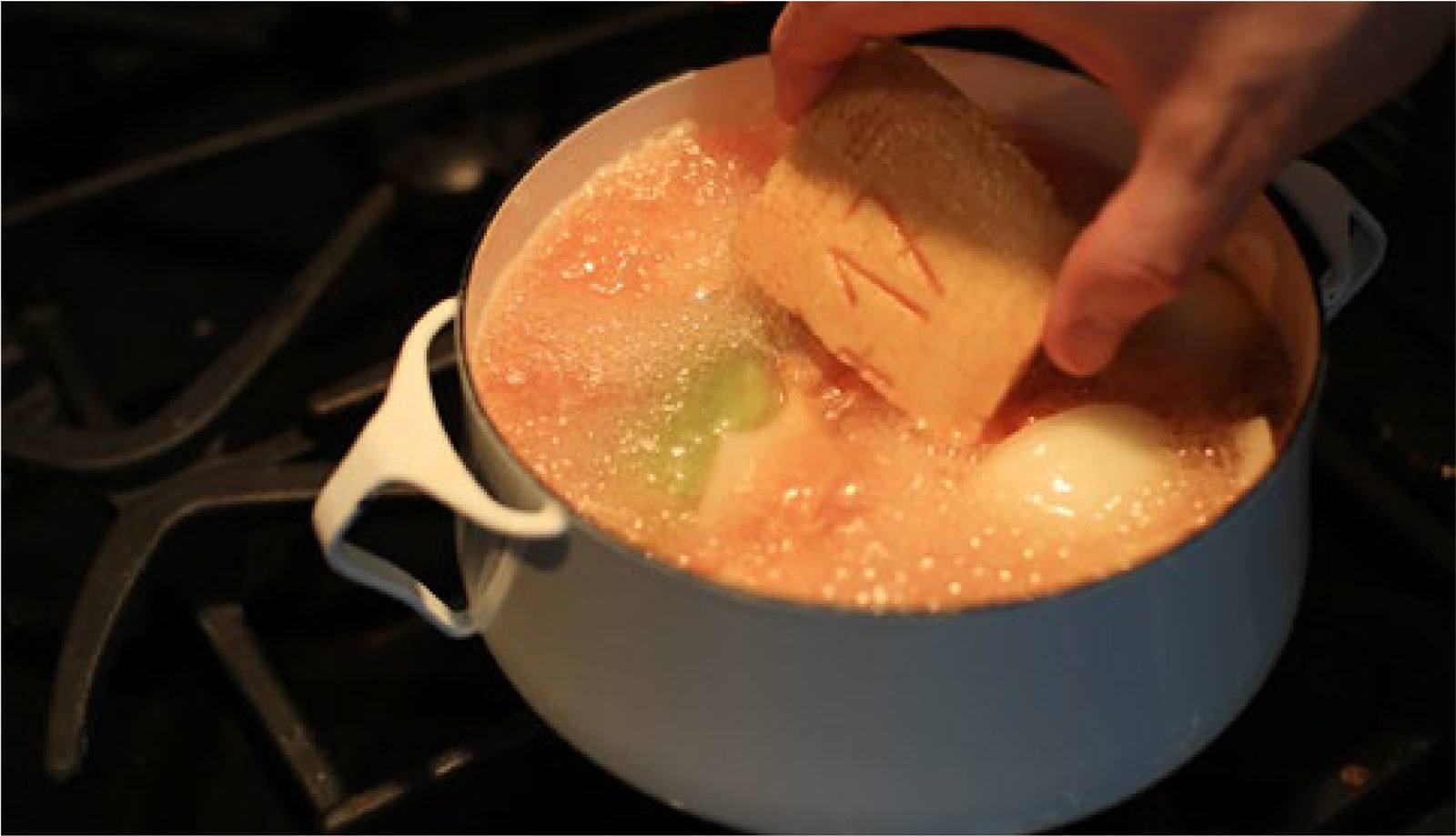
STEP 3
With clean hands, mix together the bread. Add a pinch of salt and pepper, thyme leaves and bacon. The mixture will be sticky.
STEP 4
Form the dough into balls with a diameter of approximately 1 ½ inches. Make sure the balls are compact. The mixture should yield approximately 14 balls in total.

STEP 5
Thinly slice the shallots, leek and artichokes, sauté for 4-6 minutes with a few ladles of the vegetable broth. You want the liquid to reduce by about 35%.

STEP 6
Bring remaining broth back to a boil and cook canederli in broth for 5 minutes.
STEP 7
To serve, add the artichoke mixture to the bottom of your bowl or plate. Place the canederli on top and pour some of the broth over top or leave without. Garnish with Italian parsley and shaved Parmigiano Reggiano cheese.
MAIN
Italian Dumplings with
Artichokes and Leeks
-
30m
PREP
-
30m
COOK
-
265
CALORIES
-
4
SERVINGS
These delicious Italian dumplings (they are called canederli in Italy) are made from a mixture of stale bread, eggs and milk. Canederli are a traditional dish from the Trentino-Alto Adige area, the Alpine region in North East Italy that borders with Austria. In fact, canederli are also a signature dish on the Austrian side of the border, where they are called ‘knödel’.
Chef Michele Casadei Massari gave this traditional dish a twist by adding bacon and serving them over sautéed artichokes and leeks. And, of course, garnishing them with plenty of Parmigiano Reggiano® cheese.
Ingredients:
12 oz stale bread cut into 1/2” cubes
2 large eggs
5 oz of milk
4oz of smoked bacon finely chopped
1 sprig thyme, leaves removed
Pinch of salt
Pinch of pepper
2 shallots
1 leek
4 clean artichokes
Parmigiano Reggiano cheese, shaved
Italian parsley, for garnish
For broth:
2 qt water
2 carrot
2 stalk of celery
1onion
Outer leaves of the artichokes
2 tablespoon of tomato paste
Sea salt, to taste
Look for the seal of authenticity.
For a better experience always use authentic Parmigiano Reggiano, made in Italy.

Hint:
Use Parmigiano Reggiano cheese aged over 24 months to optimize flavor and texture.
To trim artichokes, snap off and discard the tough outer green leaves until you are left with a small bullet-shaped artichoke with pale yellow leaves that are green at the tips and tender.
Pairing:
Cynar 70 Negroni
According to legend, the Negroni was invented in 1919 at Caffe Casoni in Florence, when Count Camillo Negroni asked his friend, bartender Forsco Scarselli, to strengthen his favorite cocktail – the Americano – by replacing the soda water with gin.
The recipe below adds Cynar 70 (the 70-proof formula). Cynar (pronounced CHEE-nar) is a liqueur known for its stomach-soothing qualities. Specifically, Cynar is a digestivo, an almost-medicinal Italian after-dinner drink. It is made by steeping herbs (13 in this case) in a neutral spirit. But what makes the spirit really stand out is its primary ingredient: artichokes.
Mix 1¼ oz. gin, 1¼ oz. Campari and 1¼ oz. Cynar 70. Pour over ice and garnish with a twist of Orange.
Where to buy:
MAIN
Italian Dumplings with
Artichokes and Leeks
-
30m
PREP
-
30m
COOK
-
265
CALORIES
-
4
SERVINGS
These delicious Italian dumplings (they are called canederli in Italy) are made from a mixture of stale bread, eggs and milk. Canederli are a traditional dish from the Trentino-Alto Adige area, the Alpine region in North East Italy that borders with Austria. In fact, canederli are also a signature dish on the Austrian side of the border, where they are called ‘knödel’.
Chef Michele Casadei Massari gave this traditional dish a twist by adding bacon and serving them over sautéed artichokes and leeks. And, of course, garnishing them with plenty of Parmigiano Reggiano® cheese.
Directions:

STEP 1
Place the bread in a bowl. Lightly beat the egg with the milk. Add it to the bread and mix well. Allow to soak for at least 25 minutes.

STEP 2
While the bread is soaking prepare the broth. Boil the vegetables in 2 quarts of water for 30 minutes, add salt at the end to taste. Strain the broth and return back to the pot.

STEP 3
With clean hands, mix together the bread. Add a pinch of salt and pepper, thyme leaves and bacon. The mixture will be sticky.
STEP 4
Form the dough into balls with a diameter of approximately 1 ½ inches. Make sure the balls are compact. The mixture should yield approximately 14 balls in total.

STEP 5
Thinly slice the shallots, leek and artichokes, sauté for 4-6 minutes with a few ladles of the vegetable broth. You want the liquid to reduce by about 35%.

STEP 6
Bring remaining broth back to a boil and cook canederli in broth for 5 minutes.
STEP 7
To serve, add the artichoke mixture to the bottom of your bowl or plate. Place the canederli on top and pour some of the broth over top or leave without. Garnish with Italian parsley and shaved Parmigiano Reggiano cheese.
Ingredients:
12 oz stale bread cut into 1/2” cubes
2 large eggs
5 oz of milk
4oz of smoked bacon finely chopped
1 sprig thyme, leaves removed
Pinch of salt
Pinch of pepper
2 shallots
1 leek
4 clean artichokes
Parmigiano Reggiano cheese, shaved
Italian parsley, for garnish
For broth:
2 qt water
2 carrot
2 stalk of celery
1onion
Outer leaves of the artichokes
2 tablespoon of tomato paste
Sea salt, to taste
Look for the seal of authenticity.
For a better experience always use authentic Parmigiano Reggiano, made in Italy.

Hint:
Use Parmigiano Reggiano cheese aged over 24 months to optimize flavor and texture.
To trim artichokes, snap off and discard the tough outer green leaves until you are left with a small bullet-shaped artichoke with pale yellow leaves that are green at the tips and tender.
Pairing:
Cynar 70 Negroni
According to legend, the Negroni was invented in 1919 at Caffe Casoni in Florence, when Count Camillo Negroni asked his friend, bartender Forsco Scarselli, to strengthen his favorite cocktail – the Americano – by replacing the soda water with gin.
The recipe below adds Cynar 70 (the 70-proof formula). Cynar (pronounced CHEE-nar) is a liqueur known for its stomach-soothing qualities. Specifically, Cynar is a digestivo, an almost-medicinal Italian after-dinner drink. It is made by steeping herbs (13 in this case) in a neutral spirit. But what makes the spirit really stand out is its primary ingredient: artichokes.
Mix 1¼ oz. gin, 1¼ oz. Campari and 1¼ oz. Cynar 70. Pour over ice and garnish with a twist of Orange.
Where to buy:
Complete your meal
SUBMIT YOUR RECIPES
Become a superstar!
Every month our curatorial team will review the recipes that have been submitted. If yours is selected we will send you a nice gift and will feature the recipe on our website (along with your photo and bio), and we’ll also post it on our Social Media platforms.

Italian Caviar Risotto with Parmigiano Reggiano cheese

Directions:
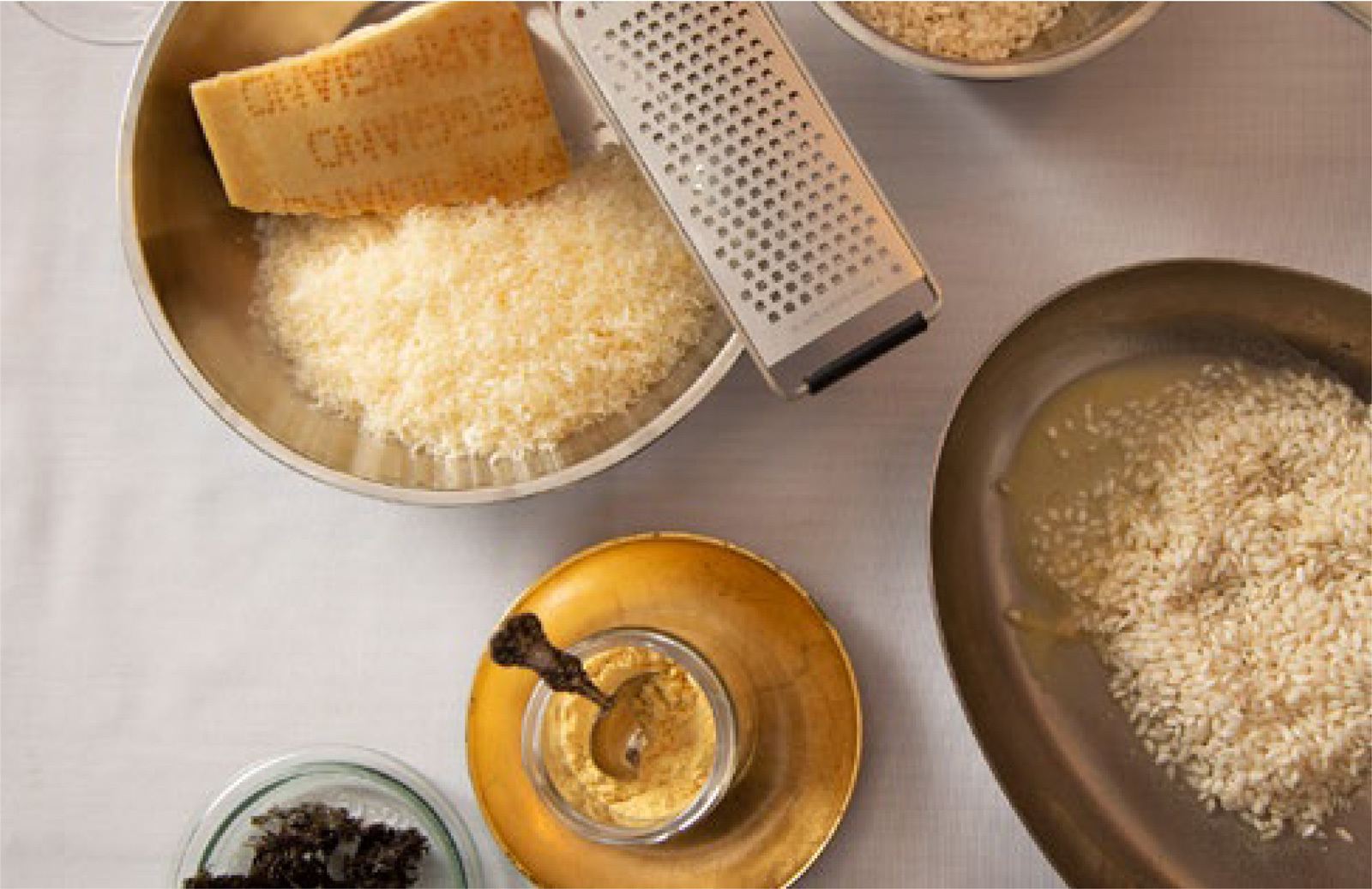
STEP 1
Place a heavy aluminum pan on low heat. Add the shallots and cook alone for 45 seconds.
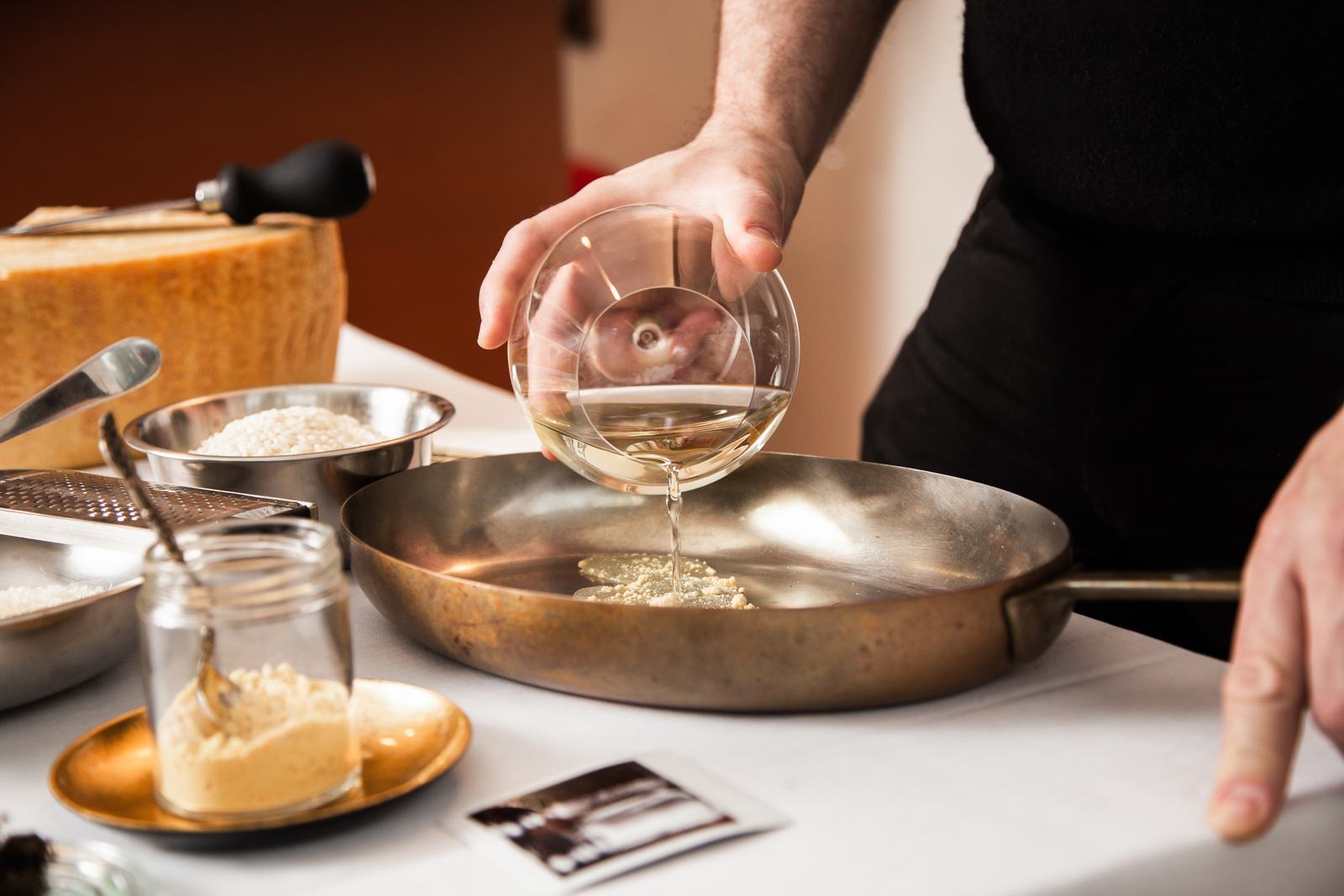
STEP 2
Add 1 cup of hot water, 1/2 cup of Chardonnay, a pinch of salt and a piece of Parmigiano Reggiano cheese rind. Let simmer for 4 minutes. This will make your Parmigiano Reggiano clear broth.

STEP 3
Add a second cup of hot water and 1 cup of rice. Whisk slowly for about 17 minutes, checking how fast the liquid is reducing. If reducing too fast, lower heat and add 1/2 cup of water to ensure risotto is “al dente” (not mushy) and the right consistency.
STEP 4
Remove from heat and take out the Parmigiano Reggiano cheese rind. Cover and let sit for 2 minutes.
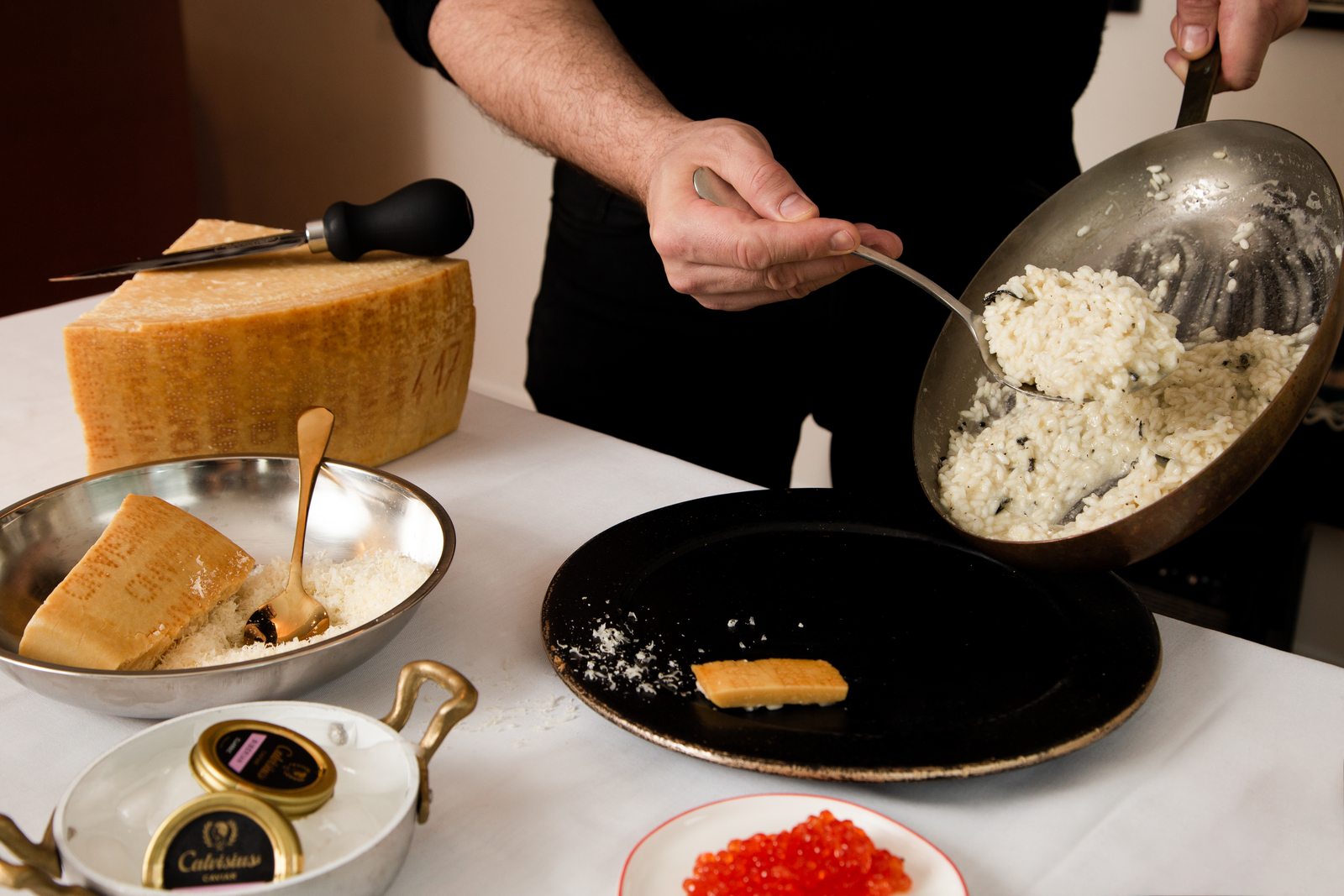
STEP 5
Add the Parmigiano Reggiano cheese, butter and the last 1/2 cup of Chardonnay. Stir vigorously to develop the desired creaminess. When plated, the proper consistency should be “all’onda” – the Italian way of describing a wave-like finish,while maintaining a creamy consistency.
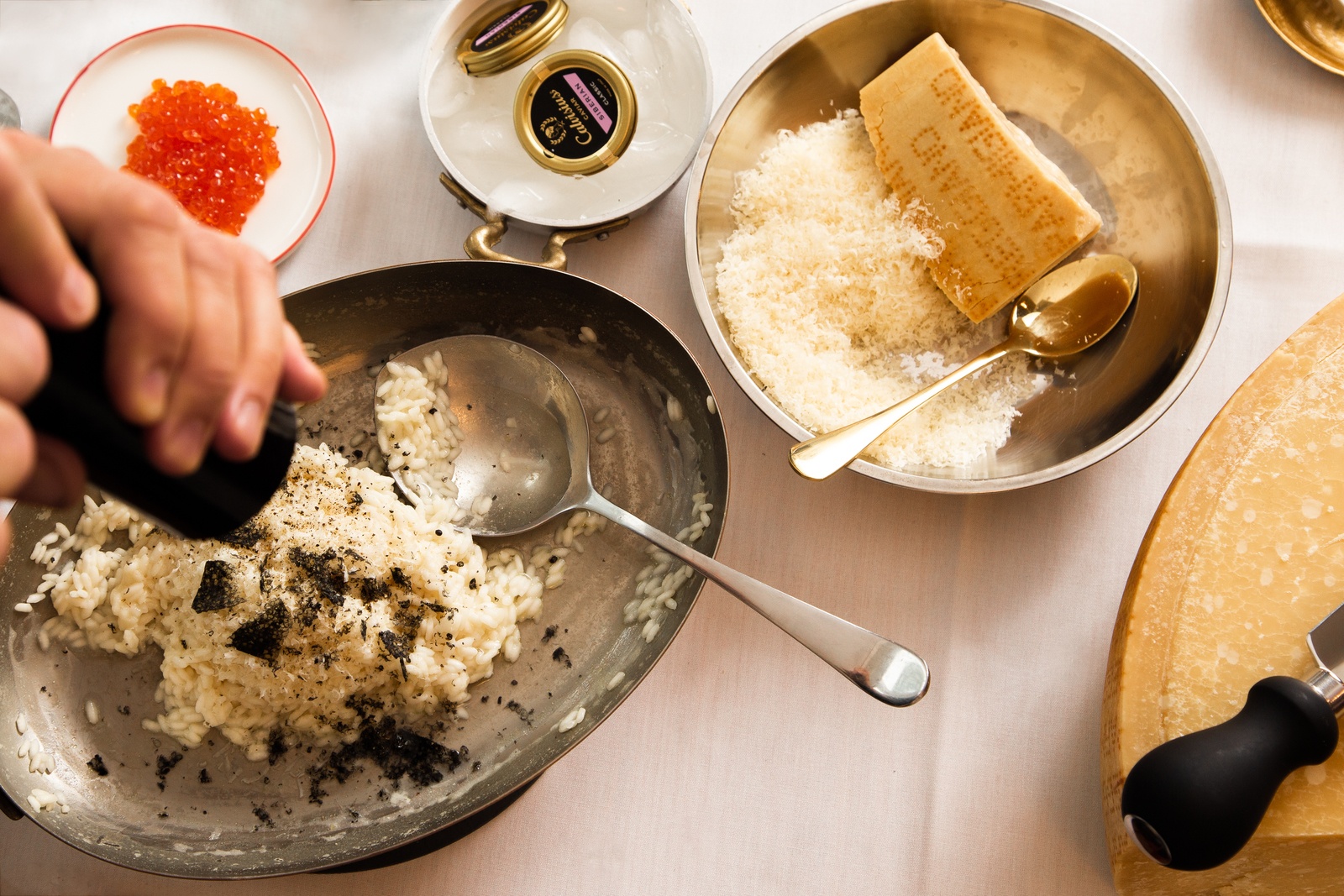
STEP 6
To serve, generously cover the rice with freshly crushed pepper, shaved caviar or nori seaweed and the caviar of your choice. We suggest enjoying this Italian Caviar Risotto with a delicious Boulevardier. Salute!
MAIN
Italian Caviar Risotto with
Parmigiano Reggiano® cheese
-
20m
PREP
-
10m
COOK
-
320
CALORIES
-
4
SERVINGS
The first recipe identifiable as “risotto” dates from 1574, when – according to legend – a young glassblower’s apprentice in Milan added saffron to a rice dish for a wedding feast as a way to add color to the dish. The guests loved the combination – and that’s how risotto was born. Of course, not all historians think this story is based on facts, but most will agree that a warm bowl of risotto can be the perfect dish for a cold winter day.
Chef Michele Casadei Massari wanted to give the otherwise rather unassuming risotto a bit of “electricity”, so he took the dish to the next level by adding Parmigiano Reggiano cheese, Chardonnay and Caviar, turning this comfort staple into a decadent treat that is rich in umami – and is destined to become one of your new favorite dishes.
Ingredients:
1oz shallots, dried
2 1/2 cups water
1 cup Chardonnay wine, room temperature
Salt (preferably Sale di Cervia)
1 cup Acquerello rice or carnaroli rice
Parmigiano Reggiano cheese rind
1 cup Parmigiano Reggiano cheese, microplaned
2 oz of unsalted European butter
Pepper ( preferably kampot pepper)
Shaved caviar or Nori Seaweed
10 grams Siberian caviar for each portion
(or any kind of black or red caviar of your preference.)
Look for the seal of authenticity.
For a better experience always use authentic Parmigiano Reggiano, made in Italy.

Hint:
Use Parmigiano Reggiano cheese aged over 36 months to optimize flavor and texture.
Acquerello rice (Acquerello is Italian for watercolor), is an aged Italian carnaroli rice that will give your risotto its creaminess and an amazing al dente texture.
European butter is typically fermented and churned longer than American butter. Also, it has a richer taste, softer texture, and a brighter yellow color than its American counterpart.
Chef Michele recommends Calvisius caviar because of the company’s sustainable practices, and the clean taste and high quality of their premium caviar.
Pairing:
Boulevardier
Employing whiskey, sweet vermouth and Campari, the Boulevardier is a variation on the classic Negroni that is adored for its deft balance of bitter, boozy and sweet qualities…and it is a perfect complement to a nice bowl of Italian Caviar Risotto with Parmigiano Reggiano.
Mix 1 oz (1 part) Cinzano Rosso, 1 oz (1 part) Campari and 1 oz (1 part) Wild Turkey 101 with ice, serve with an orange slice….and get ready for a great treat.

Where to buy:
MAIN
Italian Caviar Risotto with
Parmigiano Reggiano® cheese
-
20m
PREP
-
10m
COOK
-
320
CALORIES
-
4
SERVINGS
Rice was first introduced to Italy by the Arabs during the Middle Ages, and the first recipe identifiable as “risotto” dates from 1809, when – according to legend – a young glassblower’s apprentice in Milan added saffron to a rice dish for a wedding feast in order to delight the guests with a touch of color. Historians are not clear on the actual facts behind this legend, but most agree that a warm bowl of risotto can be the perfect dish for a cold winter day.
Chef Michele Casadei Massari wanted to give the nofrills risotto a touch of “electricity”, so he took the dish to the next level by adding Parmigiano Reggiano cheese, Chardonnay and Caviar, turning this comfort staple into a truly decadent dish, rich in umami.
Directions:

STEP 1
Place a heavy aluminum pan on low heat. Add the shallots and cook alone for 45 seconds.

STEP 2
Add 1 cup of hot water, 1/2 cup of Chardonnay, a pinch of salt and a piece of Parmigiano Reggiano cheese rind. Let simmer for 4 minutes. This will make your Parmigiano Reggiano clear broth.

STEP 3
Add a second cup of hot water and 1 cup of rice. Whisk slowly for about 17 minutes, checking how fast the liquid is reducing. If reducing to fast lower heat and add 1/2 cup of water to ensure risotto is “al dente” (bot mushy) and the right consistency.
STEP 4
Remove from heat and take out the Parmigiano Reggiano cheese rind. Cover and let sit for 2 minutes.

STEP 5
Add the Parmigiano Reggiano cheese, butter and the last 1/2 cup of Chardonnay. Stir vigorously to develop the desired creaminess. When plated, the proper consistency should be “all’onda” – the Italian way of describing a wave-like finish,while maintaining a creamy consistency.

STEP 6
To serve, generously cover the rice with freshly crushed pepper, shaved caviar or nori seaweed and the caviar of your choice. We suggest enjoying this Italian Caviar Risotto with a delicious Boulevardier. Salute!
Ingredients:
1oz shallots, dried
2 1/2 cups water
1 cup Chardonnay wine, room temperature
Salt (preferably Sale di Cervia)
1 cup Acquerello rice or carnaroli rice
Parmigiano Reggiano cheese rind
1 cup Parmigiano Reggiano cheese, microplaned
2 oz of unsalted European butter
Pepper ( preferably kampot pepper)
Shaved caviar or Nori Seaweed
10 grams Siberian caviar for each portion
(or any kind of black or red caviar of your preference.)
Look for the seal of authenticity.
For a better experience always use authentic Parmigiano Reggiano, made in Italy.

Hint:
Use Parmigiano Reggiano cheese aged over 36 months to optimize flavor and texture.
Acquerello rice (Acquerello is Italian for watercolor), is an aged Italian carnaroli rice that will give your risotto its creaminess and an amazing al dente texture.
European butter is typically fermented and churned longer than American butter. Also, it has a richer taste, softer texture, and a brighter yellow color than its American counterpart.
Chef Michele recommends Calvisius caviar because of the company’s sustainable practices, and the clean taste and high quality of their premium caviar.
Pairing:
Boulevardier
Employing whiskey, sweet vermouth and Campari, the Boulevardier is a variation on the classic Negroni that is adored for its deft balance of bitter, boozy and sweet qualities…and it is a perfect complement to a nice bowl of Italian Caviar Risotto with Parmigiano Reggiano.
Mix 1 oz (1 part) Cinzano Rosso, 1 oz (1 part) Campari and 1 oz (1 part) Wild Turkey 101 with ice, serve with an orange slice….and get ready for a great treat.

Where to buy:
Complete your meal
SUBMIT YOUR RECIPES
Become a superstar!
Every month our curatorial team will review the recipes that have been submitted. If yours is selected we will send you a nice gift and will feature the recipe on our website (along with your photo and bio), and we’ll also post it on our Social Media platforms.

Fettuccine Alfredo al Parmigiano Reggiano with Pink Peppercorn
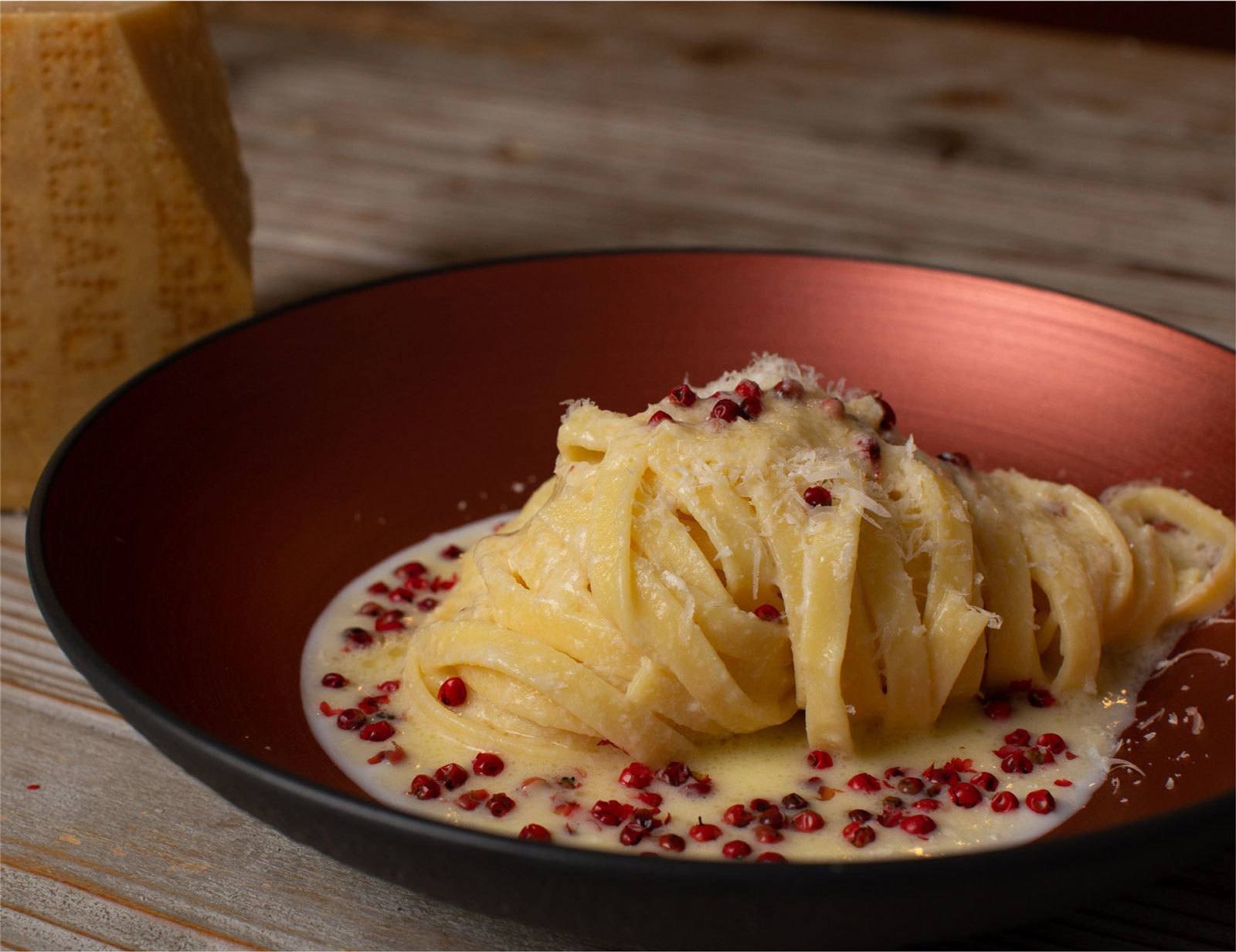
Directions:
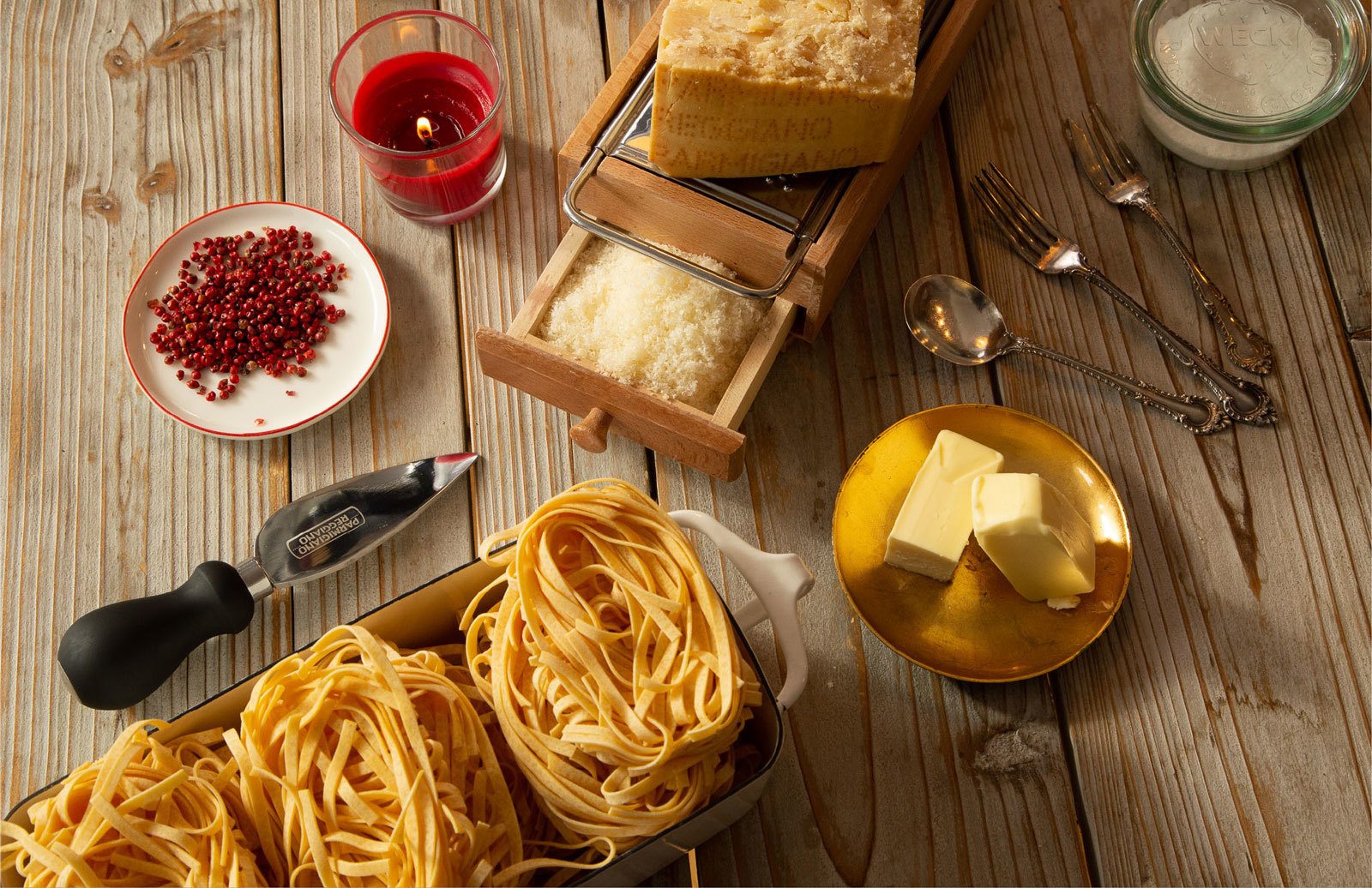
“Triple Burro”
STEP 1
Place the room temperature butter in a small mixing bowl. Add milk and whisk the mixture for 3 minutes, then store the “triple burro” in the refrigerator while cooking the rest of the dish.
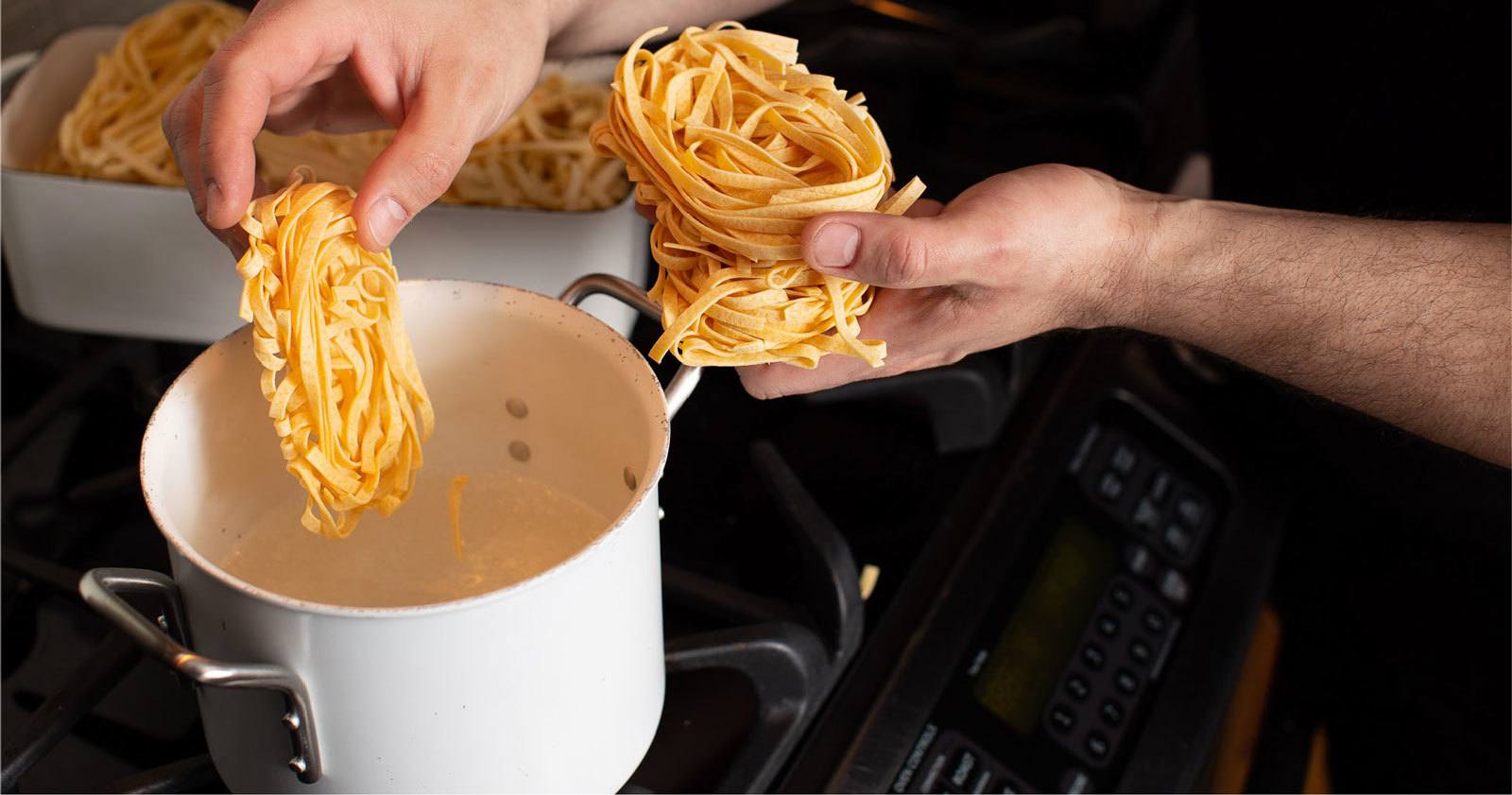
Fettuccine
STEP 2
Bring 4 – 6 quarts of water to a rolling boil in a large pot and add a pinch of salt. Add fettuccine to boiling water. Stir gently.
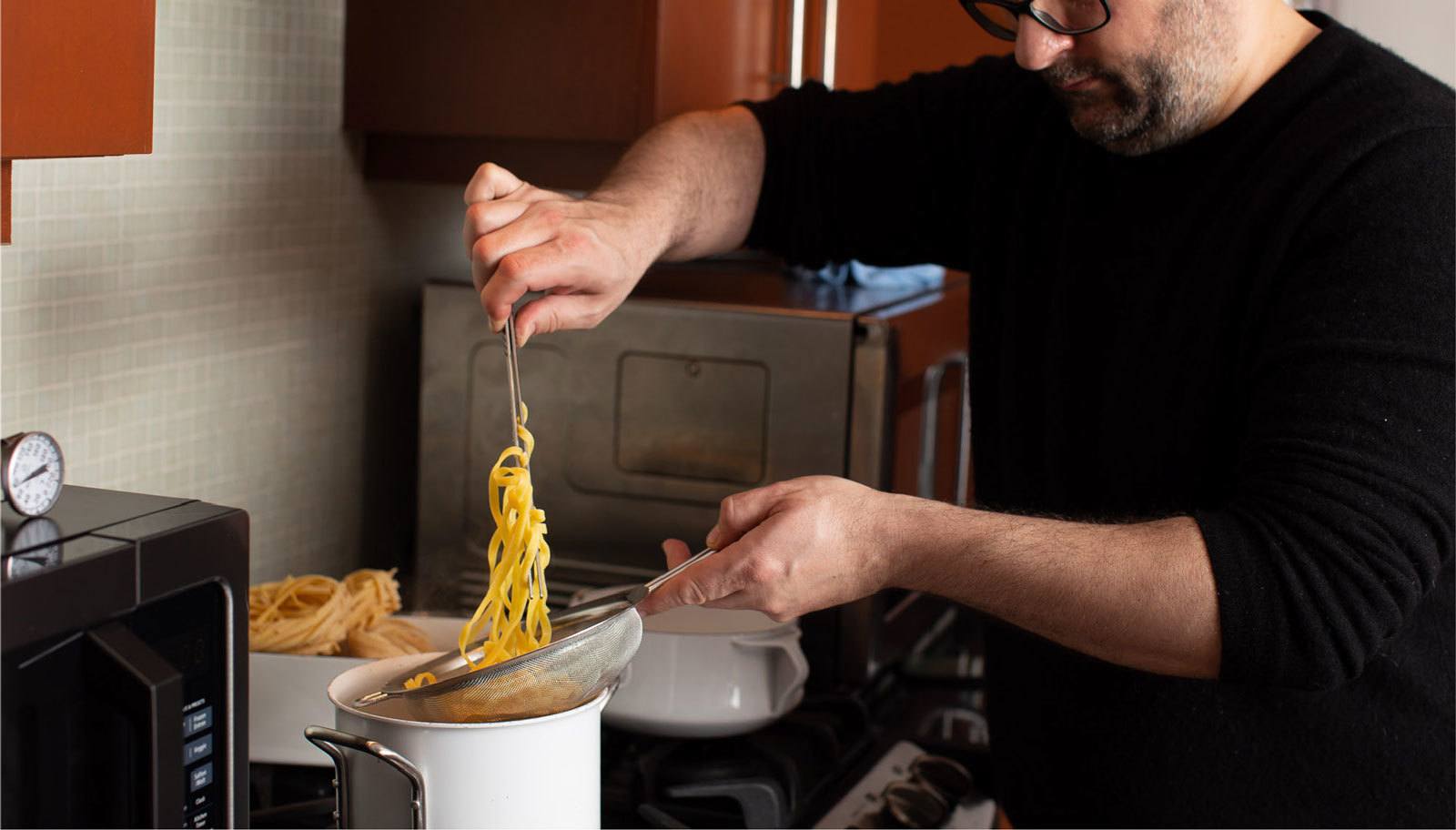
STEP 3
Return water to a boil. For authentic “al dente” pasta, boil uncovered – stirring occasionally for 12 minutes. Towards the end of the cooking time, take a couple of ladles of the pasta cooking water and set it aside. Remove the fettuccine from heat. Drain well.
STEP 4
Toast the pink peppecorn in a sauté pan over moderate heat, stirring until fragrant for 3-5 minutes, being careful not to burn the peppercorns. Also, be sure to take the “triple burro” out of the refrigerator apprx. 20 minutes before using it, so that it returns to room temperature.

STEP 5
Place the cooked fettucine in a large mixing bowl. Slowly, add the “triple burro” and a generous amount of freshly grated Parmigiano Reggiano cheese. Whisk gently to emulsify the sauce until a creamy consistency is achieved.

STEP 6
To serve it, place the fettuccine in a ceramic bowl. Add a sprinkle of pink peppercorn, and a little more grated Parmigiano Reggiano cheese.
STEP 7
Serve with love and get ready to enjoy one of Italy’s most beloved pasta dishes. Buon Appetito!
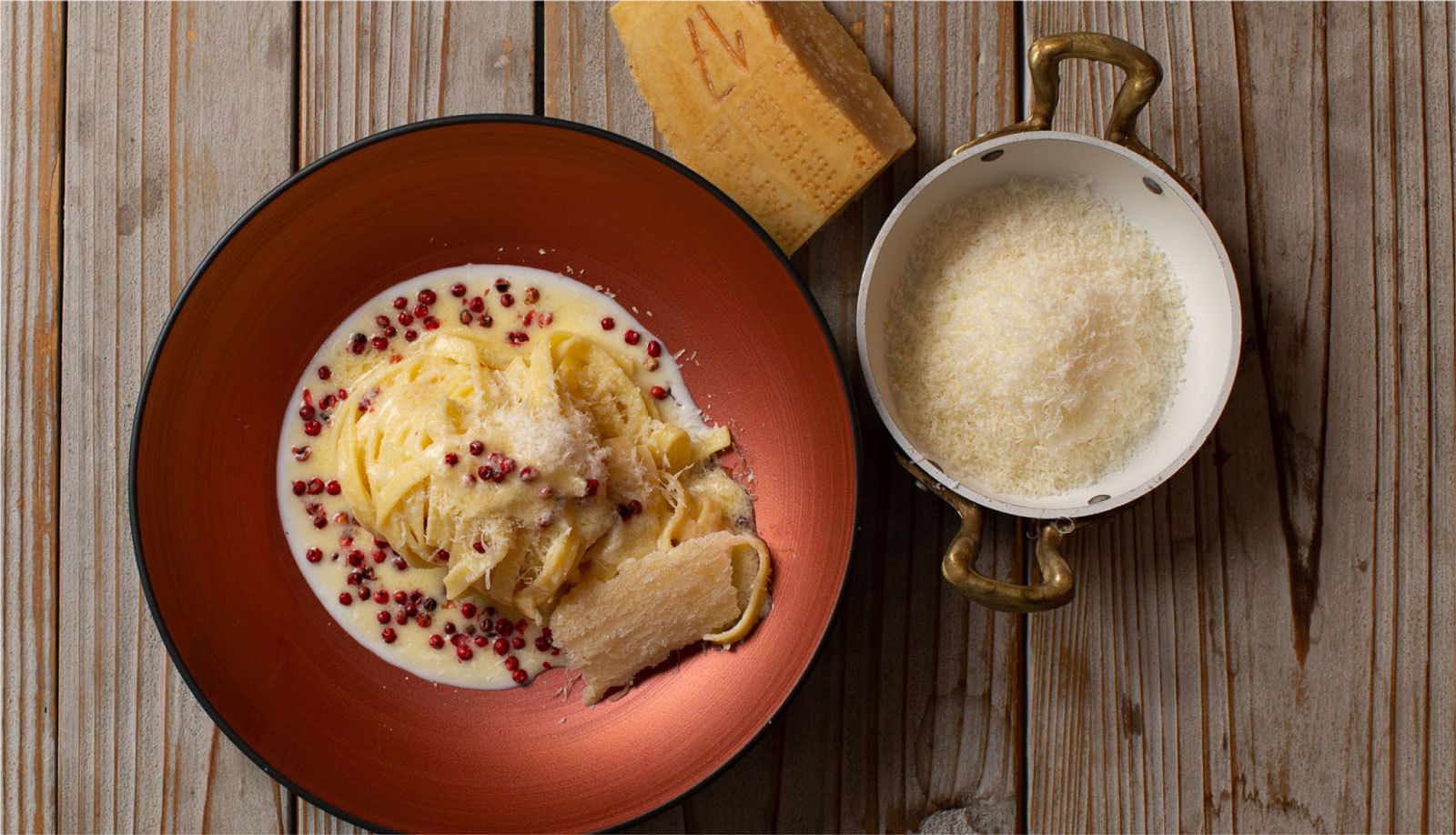
MAIN
Fettuccine Alfredo al Parmigiano Reggiano®
with Pink Peppercorn
-
15m
PREP
-
45m
COOK
-
350
CALORIES
-
4
SERVINGS
Fettuccine Alfredo is a popular Italian pasta dish tossed with butter and Parmigiano Reggiano cheese. The dish was first created in 1907 by Alfredo di Lelio – who prepared it as a gesture of love for his wife after she gave birth to their first child.
Wanting to help her feel better, Alfredo modified an existing recipe by adding more cheese and butter, turning it into a rich and creamy “triple burro” fettuccine. And, to make the experience even more romantic, he mixed the pasta using a gold spoon and fork.
Later, he featured the dish at his restaurant “Alfredo alla Scrofa” in Rome, where lucky guests were served with the famous “gold cutlery” – a ceremony that helped popularize the dish, first in Italy, then to other countries. Ultimately, Di Lelio was given the title of Knight of the Order of the Italian Crown for his contribution to Italian cuisine.
This particular variation includes pink peppercorn, which adds a touch of spice and texture to the pasta, as well as a lovely spot of color.
Ingredients:
1/2 cup unsalted European style butter
2 tablespoons organic whole milk
1 lb fettuccine pasta
6 tablespoons butter
1/4 teaspoon salt
1 1/4 cup freshly grated Parmigiano Reggiano cheese
Look for the seal of authenticity.
For a better experience always use authentic Parmigiano Reggiano, made in Italy.

Hint:
Use Parmigiano Reggiano aged over 24 months to optimize flavor and texture.
Where to buy:
MAIN
Fettuccine Alfredo al Parmigiano Reggiano®
with Pink Peppercorn
-
15m
PREP
-
45m
COOK
-
350
CALORIES
-
4
SERVINGS
Fettuccine Alfredo is a popular Italian pasta dish tossed with butter and Parmigiano Reggiano cheese. The dish was first created in 1907 by Alfredo di Lelio – who prepared it as a gesture of love for his wife after she gave birth to their first child.
Wanting to help her feel better, Alfredo modified an existing recipe by adding more cheese and butter, turning it into a rich and creamy “triple burro” fettuccine. And, to make the experience even more romantic, he mixed the pasta using a gold spoon and fork.
Later, he featured the dish at his restaurant “Alfredo alla Scrofa” in Rome, where lucky guests were served with the famous “gold cutlery” – a ceremony that helped popularize the dish, first in Italy, then to other countries. Ultimately, Di Lelio was given the title of Knight of the Order of the Italian Crown for his contribution to Italian cuisine.
This particular variation includes pink peppercorn, which adds a touch of spice and texture to the pasta, as well as a lovely spot of color.
Directions:

“Triple Burro”
STEP 1
Place the room temperature butter in a small mixing bowl. Add milk and whisk the mixture for 3 minutes, then store the “triple burro” in the refrigerator while cooking the rest of the dish.

Fettuccine
STEP 2
Bring 4 – 6 quarts of water to a rolling boil in a large pot and add a pinch of salt. Add fettuccine to boiling water. Stir gently.

STEP 3
Return water to a boil. For authentic “al dente” pasta, boil uncovered – stirring occasionally for 12 minutes. Towards the end of the cooking time, take a couple of ladles of the pasta cooking water and set it aside. Remove the fettuccine from heat. Drain well.
STEP 4
Toast the pink peppecorn in a sauté pan over moderate heat, stirring until fragrant for 3-5 minutes, being careful not to burn the peppercorns. Also, be sure to take the “triple burro” out of the refrigerator apprx. 20 minutes before using it, so that it returns to room temperature.

STEP 5
Place the cooked fettucine in a large mixing bowl. Slowly, add the “triple burro” and a generous amount of freshly grated Parmigiano Reggiano cheese. Whisk gently to emulsify the sauce until a creamy consistency is achieved.

STEP 6
To serve it, place the fettuccine in a ceramic bowl. Add a sprinkle of pink peppercorn, and a little more grated Parmigiano Reggiano cheese.
STEP 7
Serve with love and get ready to enjoy one of Italy’s most beloved pasta dishes. Buon Appetito!

Ingredients:
1/2 cup unsalted European style butter
2 tablespoons organic whole milk
1 lb fettuccine pasta
6 tablespoons butter
1/4 teaspoon salt
1 1/4 cup freshly grated Parmigiano Reggiano cheese
Look for the seal of authenticity.
For a better experience always use authentic Parmigiano Reggiano, made in Italy.

Hint:
Use Parmigiano Reggiano aged over 24 months to optimize flavor and texture.
Where to buy:
SUBMIT YOUR RECIPES
Become a superstar!
Every month our curatorial team will review the recipes that have been submitted. If yours is selected we will send you a nice gift and will feature the recipe on our website (along with your photo and bio), and we’ll also post it on our Social Media platforms.

Creamy Semolina with White Truffles and Parmigiano Reggiano cheese
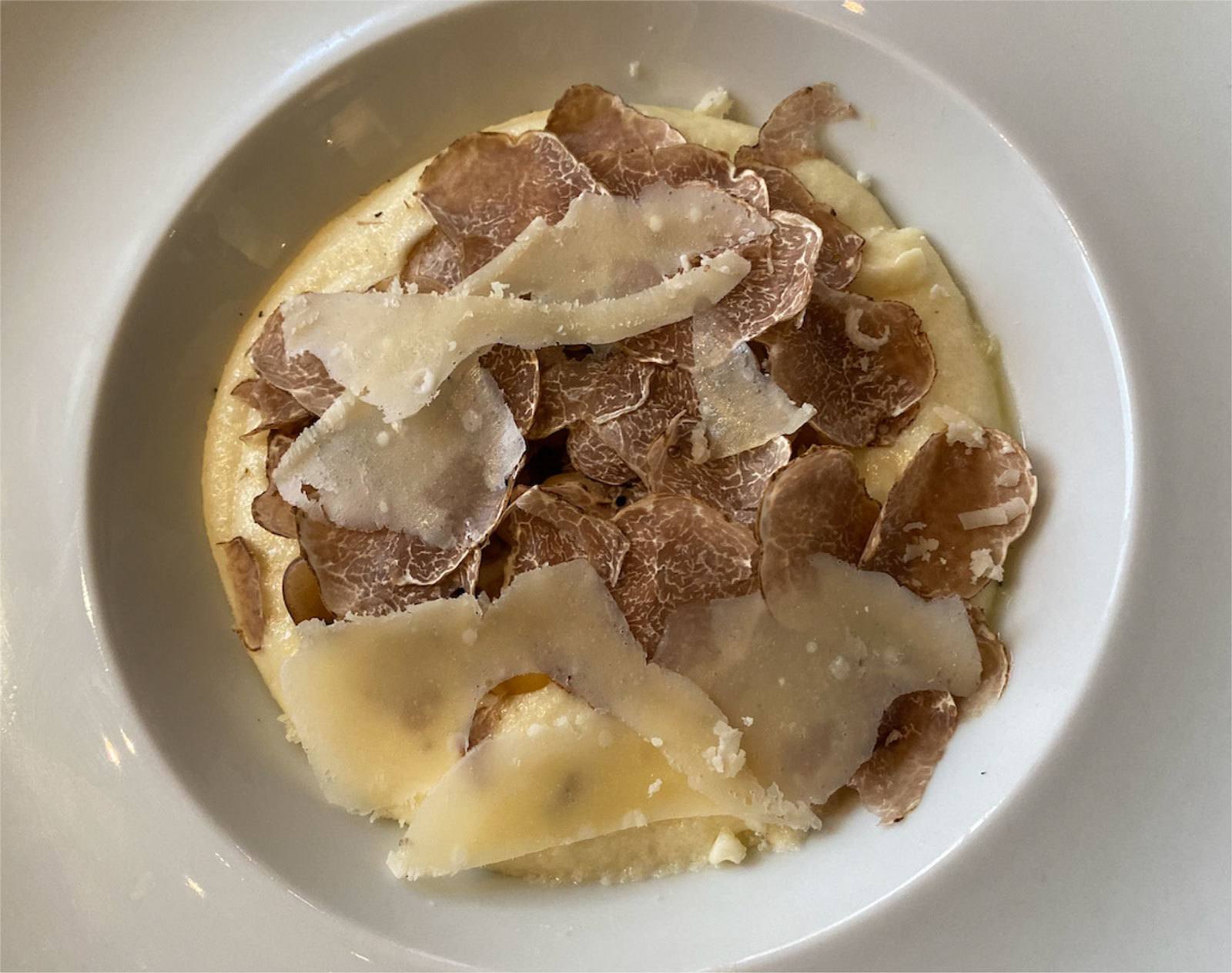
Directions:
STEP 1
In a large saucepan, bring the milk to a gentle simmer. Rain in the semolina slowly, whisking all the while to prevent clumping. Reduce the heat to a simmer; add 2 tablespoons of the butter, 2 teaspoons salt, and a few grinds of pepper and let the semolina cook gently, stirring occasionally, until it’s thick and the semolina is cooked through, about 45 minutes.
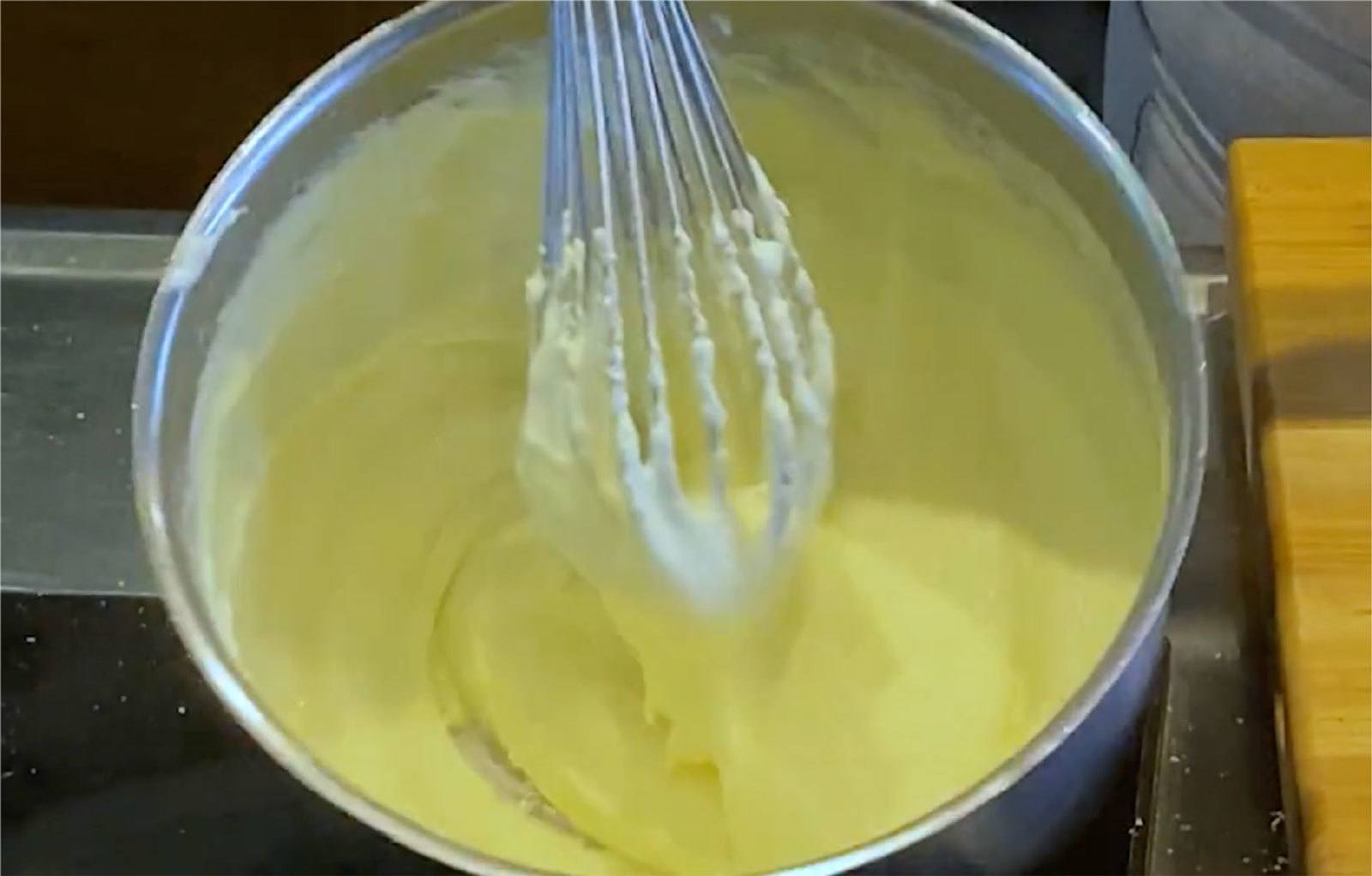
STEP 2
Stir in the remaining butter and ¼ cup grated Parmigiano Reggiano cheese and continue to cook for an additional 10 minutes or so, stirring occasionally. Taste and season with salt and pepper, if needed.
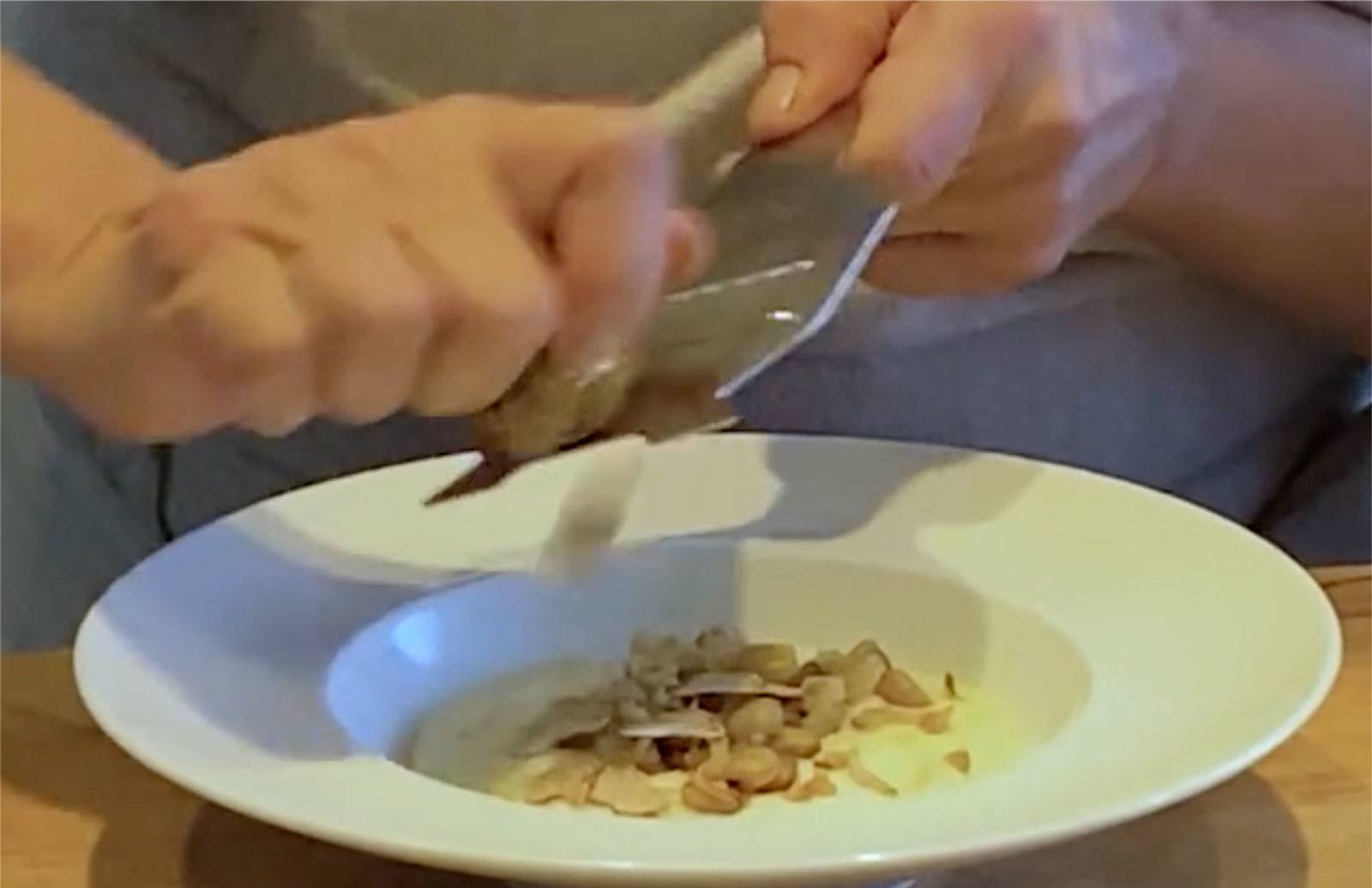
STEP 3
To serve, spoon the semolina into a shallow bowl, top with ¼ cup ceci beans, shaved white Alba truffles from Urbani, and a generous portion of shaved or grated Parmigiano Reggiano cheese. Serve immediately.
MAIN COURSE
Creamy Semolina with White Truffles and Parmigiano Reggiano® cheese
-
10m
PREP
-
1hr
COOK
-
560
CALORIES
-
4
SERVINGS
We love this recipe because it’s so simple and so comforting. Even the cooking process is relaxing. Make sure to give the semolina the full amount of time to cook, otherwise it will still be a little gritty! Serve it alongside duck breast or short rib. The Urbani white truffles and the Parmigiano Reggiano cheese give this hearty dish a rich and savory taste, which pairs wonderfully with a nice bottle of Barolo.
Recipe by Chef Barbara Lynch
This recipe is featured in Cook with Jacques Pépin & Friends: Volume 1 (Video Recipe Book)
In collaboration with:
Urbani Truffles
Prunotto Wines
Ingredients:
2 cups heavy cream (or milk)
2 cups semolina
4 tablespoons unsalted butter
½ cup grated Parmigiano Reggiano cheese
1 cup cooked heirloom ceci beans or chickpeas
Urbani White Alba truffle shavings
1 small chunk of Parmigiano Reggiano cheese
Kosher salt
Freshly ground black pepper
Look for the seal of authenticity.
For a better experience always use authentic Parmigiano Reggiano, made in Italy.

Hint:
Use Parmigiano Reggiano cheese aged over 24 months to optimize flavor and texture.
SUGGESTED PAIRING
Prunotto Bussia Barolo
Made of 100% Nebbiolo, the wine’s full body and significant structure make it an ideal match to this dish.

Parmigiano Reggiano is pleased to support the Jacques Pépin Foundation
The Jacques Pépin Foundation was created in 2016 by Jacques Pépin, Claudine Pépin and her husband, Rollie Wesen. The mission of the JPF is to improve lives and strengthen communities through culinary education and training.
For decades, Jacques has taught essential skills to aspiring professionals at the International Culinary Center and Boston University. Skills in the kitchen, and the associated teaching from Jacques and others, can bring entertainment and pleasure, as well as purpose, self-confidence, and pathways to better health and employment opportunities.
The annual membership fees to the JPF support community-based culinary training that offers essential culinary and life skills for individuals with barriers to employment – such as previous incarceration, homelessness and substance abuse.
MAIN COURSE
Creamy Semolina with White Truffles and Parmigiano Reggiano® cheese
-
10m
PREP
-
1hr
COOK
-
560
CALORIES
-
4
SERVINGS
We love this recipe because it’s so simple and so comforting. Even the cooking process is relaxing. Make sure to give the semolina the full amount of time to cook, otherwise it will still be a little gritty! Serve it alongside duck breast or short rib. The Urbani white truffles and the Parmigiano Reggiano cheese give this hearty dish a rich and savory taste, which pairs wonderfully with a nice bottle of Barolo.
Recipe by Chef Barbara Lynch
This recipe is featured in Cook with Jacques Pépin & Friends: Volume 1 (Video Recipe Book)
In collaboration with:
Urbani Truffles
Prunotto Wines
Directions:
STEP 1
In a large saucepan, bring the milk to a gentle simmer. Rain in the semolina slowly, whisking all the while to prevent clumping. Reduce the heat to a simmer; add 2 tablespoons of the butter, 2 teaspoons salt, and a few grinds of pepper and let the semolina cook gently, stirring occasionally, until it’s thick and the semolina is cooked through, about 45 minutes.

STEP 2
Stir in the remaining butter and ¼ cup grated Parmigiano Reggiano cheese and continue to cook for an additional 10 minutes or so, stirring occasionally. Taste and season with salt and pepper, if needed.

STEP 3
To serve, spoon the semolina into a shallow bowl, top with ¼ cup ceci beans, shaved white Alba truffles from Urbani, and a generous portion of shaved or grated Parmigiano Reggiano cheese. Serve immediately.
Ingredients:
2 cups heavy cream (or milk)
2 cups semolina
4 tablespoons unsalted butter
½ cup grated Parmigiano Reggiano cheese
1 cup cooked heirloom ceci beans or chickpeas
Urbani White Alba truffle shavings
1 small chunk of Parmigiano Reggiano cheese
Kosher salt
Freshly ground black pepper
Look for the seal of authenticity.
For a better experience always use authentic Parmigiano Reggiano, made in Italy.

Hint:
Use Parmigiano Reggiano cheese aged over 24 months to optimize flavor and texture.
SUGGESTED PAIRING
Prunotto Bussia Barolo
Made of 100% Nebbiolo, the wine’s full body and significant structure make it an ideal match to this dish.

Parmigiano Reggiano is pleased to support the Jacques Pépin Foundation
The Jacques Pépin Foundation was created in 2016 by Jacques Pépin, Claudine Pépin and her husband, Rollie Wesen. The mission of the JPF is to improve lives and strengthen communities through culinary education and training.
For decades, Jacques has taught essential skills to aspiring professionals at the International Culinary Center and Boston University. Skills in the kitchen, and the associated teaching from Jacques and others, can bring entertainment and pleasure, as well as purpose, self-confidence, and pathways to better health and employment opportunities.
The annual membership fees to the JPF support community-based culinary training that offers essential culinary and life skills for individuals with barriers to employment – such as previous incarceration, homelessness and substance abuse.
Where to buy:
Complete your meal
SUBMIT YOUR RECIPES
Become a superstar!
Every month our curatorial team will review the recipes that have been submitted. If yours is selected we will send you a nice gift and will feature the recipe on our website (along with your photo and bio), and we’ll also post it on our Social Media platforms.

Passatelli with Parmigiano Reggiano
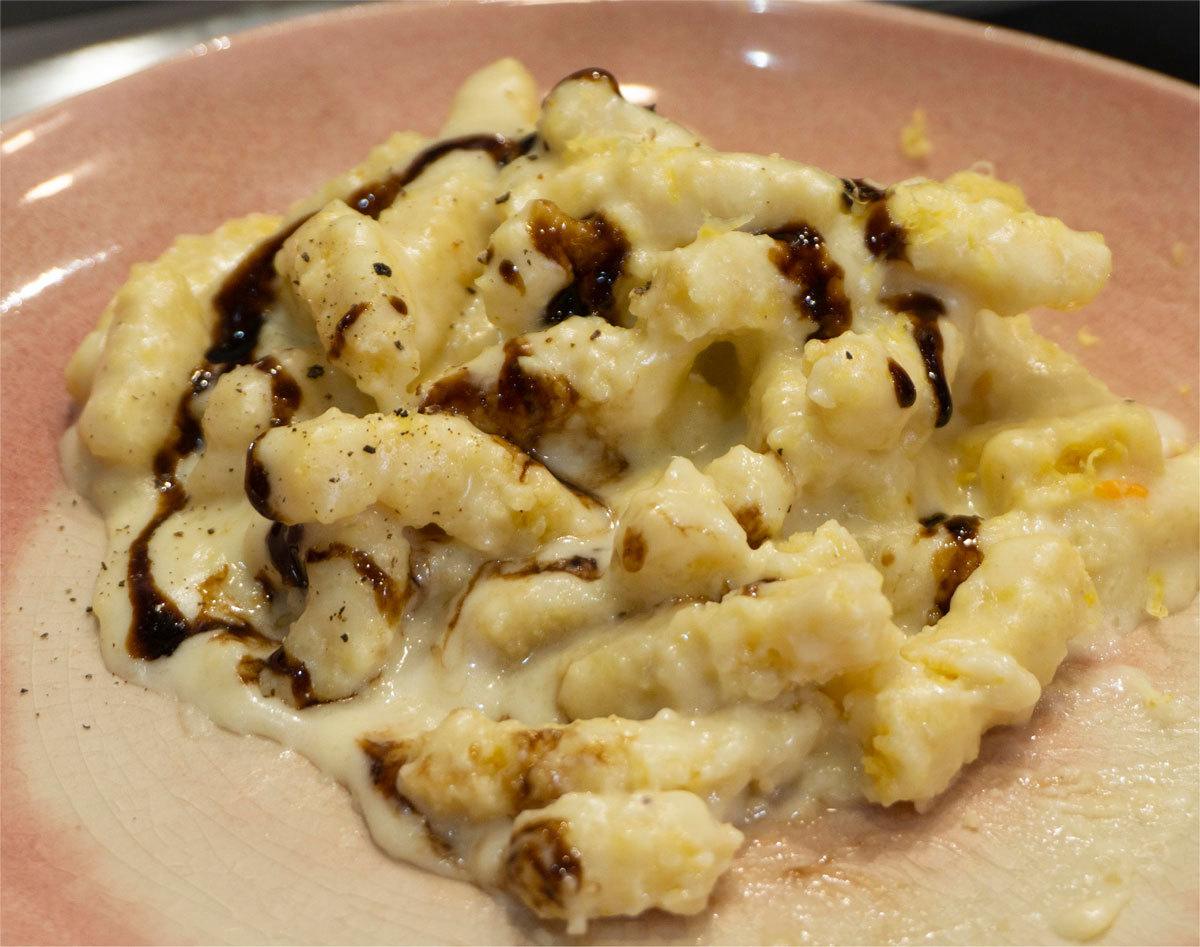
Directions:
Parmigiano Reggiano cream
STEP 1
To make Parmigiano Reggiano cream, first heat the cream in a saucepan. Add the grated Parmigiano Reggiano cheese 1 tablespoon at a time, continuing to stir with a whisk. Continue stirring over a low flame until all the cheese is used.
STEP 2
In the end, the consistency should be similar to a custard. Complete with a pinch of salt and nutmeg.
Passatelli
STEP 1
Mix dry ingredients in a medium bowl. Stir the eggs in with a fork until a dough forms. Dough should be soft, and a little bit sticky, but not too much. Add a bit of flour or breadcrumbs if very wet. Cover with plastic wrap and let dough rest for about 10 minutes or so.
STEP 2
Bring broth to a gentle boil
STEP 3
Working with ¼ of the dough at a time, place each portion into a large-holed potato ricer. Press the dough through the ricer. To release the pasatelli, scrape off the strands with the edge of a sharp knife. Let the strands fall directly into the boiling broth. The passatelli strands will be just over an inch long. Cook until the strands float to the top, just a minute or so. Continue with the rest of the dough. With a spider strainer or a large slotted spoon, transfer the passatelli to bowls for serving keeping them in a warm oven.
STEP 4
When all the passatelli are cooked, ladle some broth or the Parmigiano Reggiano cream into the passatelli-filled bowls and serve immediately, adding extra grated Parmigiano Reggiano cheese and a drizzle of balsamic vinegar aged 25 years. Serve immediately. Smile!
MAIN COURSE
Passatelli with Parmigiano Reggiano® Cream and Balsamic Vinegar
-
20m
PREP
-
10m
COOK
-
390
CALORIES
-
4
SERVINGS
Although it is classified as “pasta”, the soft strands of passatelli are made of breadcrumbs instead of flour. This traditional dish was popular in the rural low-income areas of Italy, where people used leftovers and simple foods like stale bread, cheese and eggs to create tasty dishes. Today, passatelli are mostly homemade and are often combined with grated Parmigiano Reggiano cheese and eggs for a delicious and hearty meal. In this particular variation Chef Michele combines passatelli with a Parmigiano Reggiano cream and finishes it with a delicate drizzle of aged balsamic vinegar.
Ingredients:
Parmigiano Reggiano cream
6oz heavy cream
2oz grated Parmigiano Reggiano cheese
Nutmeg
Black Pepper
Passatelli
6oz bread crumbs
7oz finely grated Parmigiano Reggiano cheese, plus more for serving
A touch nutmeg
A touch of lemon zest
A touch salt
3 large brown eggs
Chicken broth (for cooking passatelli)
Aged Balsamic vinegar (25 years)
Look for the seal of authenticity.
For a better experience always use authentic Parmigiano Reggiano, made in Italy.

Hint:
Use Parmigiano Reggiano cheese aged over 24 months to optimize flavor and texture.
MAIN COURSE
Passatelli with Parmigiano Reggiano® Cream and Balsamic Vinegar
-
20m
PREP
-
10m
COOK
-
390
CALORIES
-
4
SERVINGS
Although it is classified as “pasta”, the soft strands of passatelli are made of breadcrumbs instead of flour. This traditional dish was popular in the rural low-income areas of Italy, where people used leftovers and simple foods like stale bread, cheese and eggs to create tasty dishes. Today, passatelli are mostly homemade and are often combined with grated Parmigiano Reggiano cheese and eggs for a delicious and hearty meal. In this particular variation Chef Michele combines passatelli with a Parmigiano Reggiano cream and finishes it with a delicate drizzle of aged balsamic vinegar.
Directions:
Parmigiano Reggiano cream
STEP 1
To make Parmigiano Reggiano cream, first heat the cream in a saucepan. Add the grated Parmigiano Reggiano cheese 1 tablespoon at a time, continuing to stir with a whisk. Continue stirring over a low flame until all the cheese is used.
STEP 2
In the end, the consistency should be similar to a custard. Complete with a pinch of salt and nutmeg.
Passatelli
STEP 1
Mix dry ingredients in a medium bowl. Stir the eggs in with a fork until a dough forms. Dough should be soft, and a little bit sticky, but not too much. Add a bit of flour or breadcrumbs if very wet. Cover with plastic wrap and let dough rest for about 10 minutes or so.
STEP 2
Bring broth to a gentle boil
STEP 3
Working with ¼ of the dough at a time, place each portion into a large-holed potato ricer. Press the dough through the ricer. To release the pasatelli, scrape off the strands with the edge of a sharp knife. Let the strands fall directly into the boiling broth. The passatelli strands will be just over an inch long. Cook until the strands float to the top, just a minute or so. Continue with the rest of the dough. With a spider strainer or a large slotted spoon, transfer the passatelli to bowls for serving keeping them in a warm oven.
STEP 4
When all the passatelli are cooked, ladle some broth or the Parmigiano Reggiano cream into the passatelli-filled bowls and serve immediately, adding extra grated Parmigiano Reggiano cheese and a drizzle of balsamic vinegar aged 25 years. Serve immediately. Smile!
Ingredients:
Parmigiano Reggiano cream
6oz heavy cream
2oz grated Parmigiano Reggiano cheese
Nutmeg
Black Pepper
Passatelli
6oz bread crumbs
7oz finely grated Parmigiano Reggiano cheese, plus more for serving
A touch nutmeg
A touch of lemon zest
A touch salt
3 large brown eggs
Chicken broth (for cooking passatelli)
Aged Balsamic vinegar (25 years)
Look for the seal of authenticity.
For a better experience always use authentic Parmigiano Reggiano, made in Italy.

Hint:
Use Parmigiano Reggiano cheese aged over 24 months to optimize flavor and texture.
Where to buy:
Complete your meal
SUBMIT YOUR RECIPES
Become a superstar!
Every month our curatorial team will review the recipes that have been submitted. If yours is selected we will send you a nice gift and will feature the recipe on our website (along with your photo and bio), and we’ll also post it on our Social Media platforms.

Tortellini in Brodo
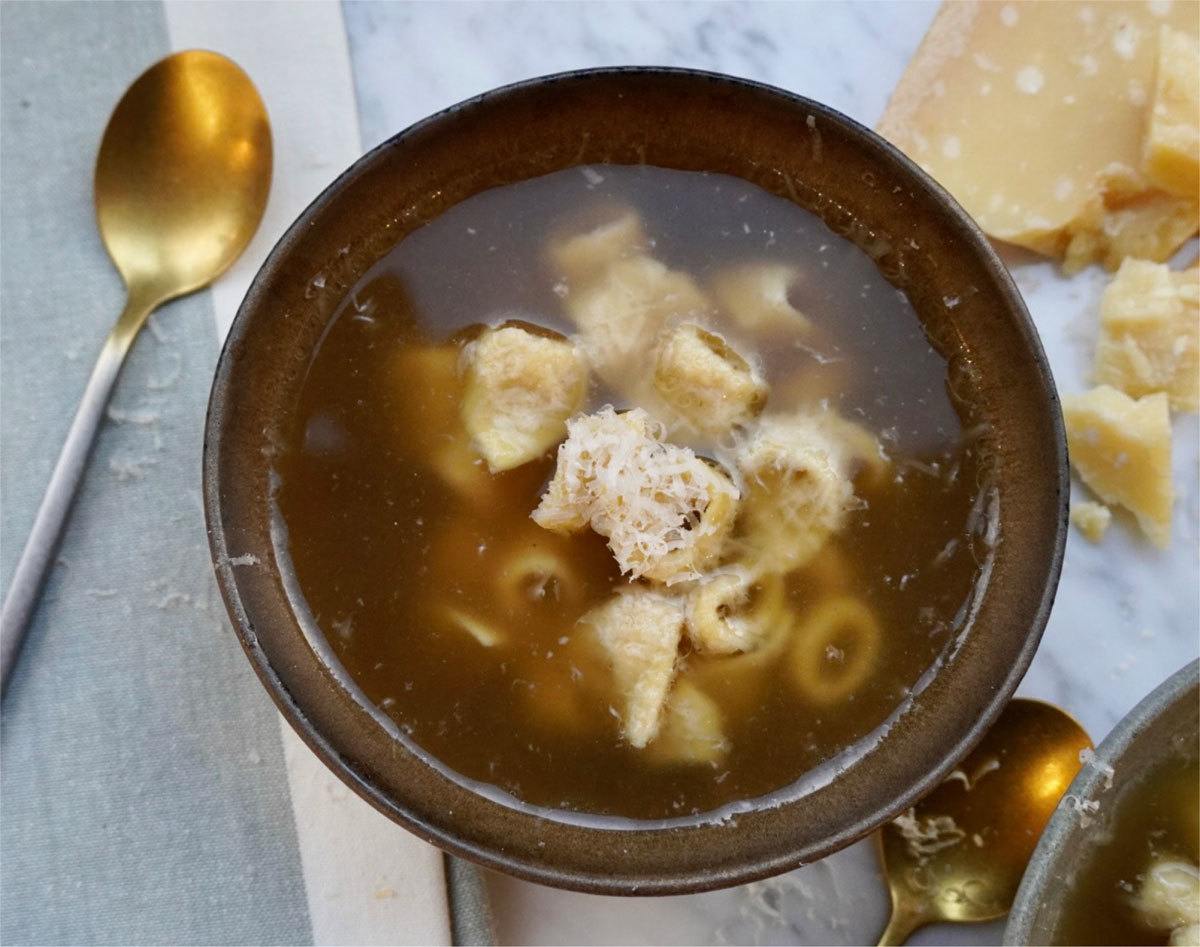
Directions:
STEP 1
To a large Dutch oven add chicken bones, water, onion, carrots and celery. To a cheesecloth, add peppercorns, Parmigiano Reggiano cheese rind and thyme sprigs, seal with twine and place into stock. Bring to a simmer and allow to cook for 2 ½ to 3 hours. Skimming the top of fat and foam. Once finished, remove from heat, strain and season.
STEP 2
On a clean work surface, add both flours and mix. Create a well in the center, add eggs and using a fork or hands, slowly incorporate until a dough forms. Cover dough and let rest for at least 30 minutes.
STEP 3
Meanwhile, to the bowl of a food processor, add pork, prosciutto, mortadella, Parmigiano Reggiano cheese and eggs. Pulse until almost smooth. Season with fresh nutmeg, salt and pepper. Remove to a bowl.
STEP 4
Cut pasta dough into 4 pieces. Using a pasta machine roll out to the thinnest setting. Cut sheets into 1” squares. Place about 1 teaspoon of filling onto each square. Fold the square diagonally in half to create a triangle and seal the pasta. Then fold again, so that the corners of the triangle come together.
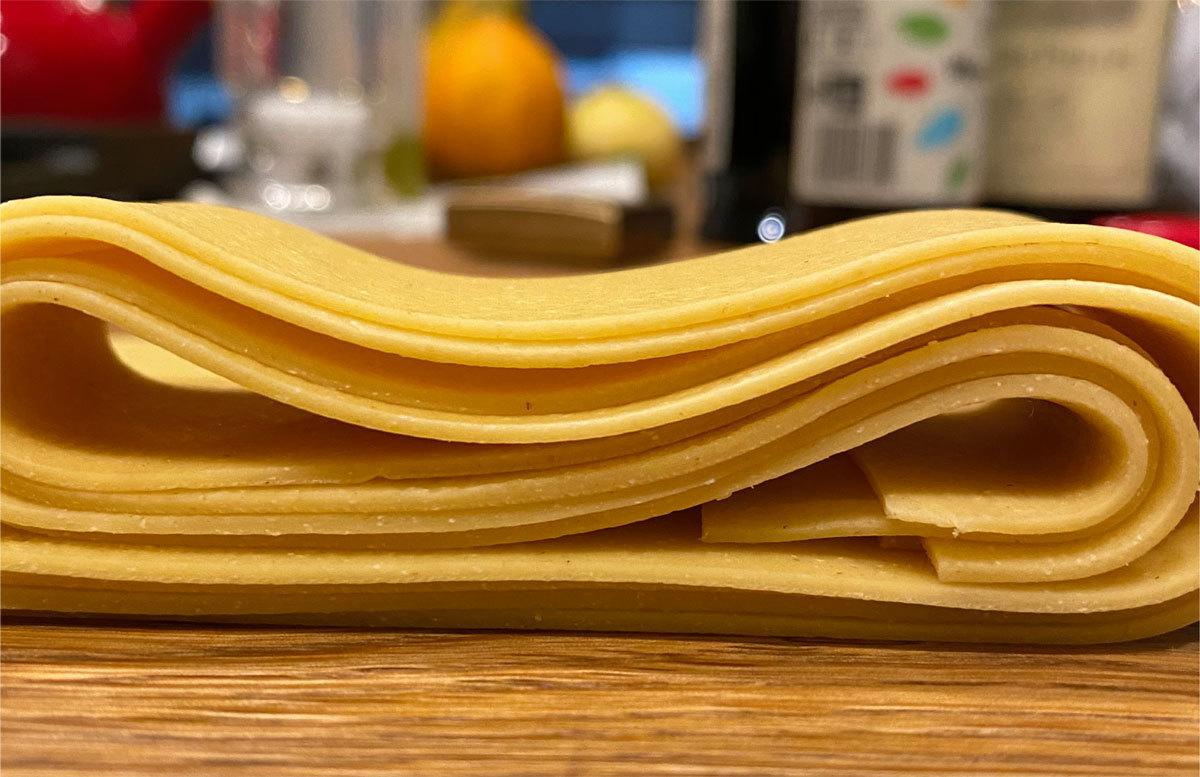
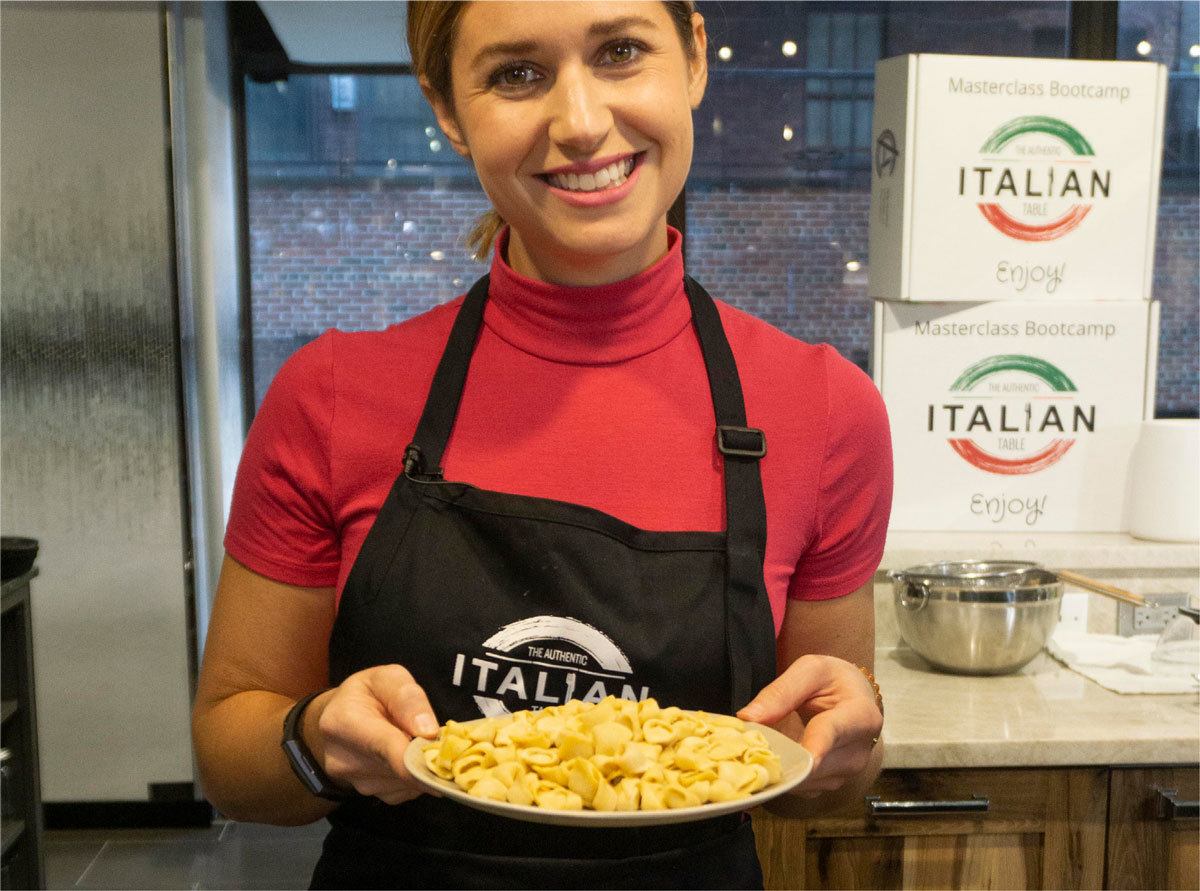
STEP 5
Once all tortellini is made, either freeze or use right away! Bring broth to a simmer. Add tortellini and cook 3-4 minutes. Divide in between serving bowls and garnish with freshly grated Parmigiano Reggiano cheese.
MAIN COURSE
Tortellini in Brodo
-
30m
PREP
-
3hrs
COOK
-
175
CALORIES
-
10
SERVINGS
Tortellini in Brodo is a classic Italian dish originating from the Emilia-Romagna region, specifically Bologna and Modena. There are many variations of filling and broth (“brodo” is “broth” in Italian). This dish is traditionally served in a capon or meat bone broth. This version uses chicken bones to create an ultra clear broth that lets the salty, flavorful filling of the tortellini shine through! A truly delicious filling should only be showcased in a simple broth. It is the ultimate way to let the filling have the stage. And a generous topping of Parmigiano Reggiano cheese adds more taste and texture to this comforting dish.
Ingredients:
Broth
4 Lbs chicken bones (wings & carcass)
3 quarts water
1 onion (quartered with skin on)
2 carrots
2 stalks celery
1 tablespoon black peppercorns
1 Parmigiano Reggiano cheese rind
2 sprigs fresh thyme
Kosher salt, to taste
Egg pasta dough
100 grams 00 flour
100 grams semolina flour
2 large eggs (100 grams)
Filling
¼ Lb ground pork
¼ Lb prosciutto
¼ Lb mortadella
½ cup freshly grated Parmigiano Reggiano cheese
2 large eggs
Fresh nutmeg, to taste
Kosher salt and freshly ground black pepper, to taste
Look for the seal of authenticity.
For a better experience always use authentic Parmigiano Reggiano, made in Italy.

Hint:
Use Parmigiano Reggiano cheese aged over 24 months to optimize flavor and texture.
MAIN COURSE
Tortellini in Brodo
-
30m
PREP
-
3hrs
COOK
-
175
CALORIES
-
10
SERVINGS
Tortellini in Brodo is a classic Italian dish originating from the Emilia-Romagna region, specifically Bologna and Modena. There are many variations of filling and broth (“brodo” is “broth” in Italian). This dish is traditionally served in a capon or meat bone broth. This version uses chicken bones to create an ultra clear broth that lets the salty, flavorful filling of the tortellini shine through! A truly delicious filling should only be showcased in a simple broth. It is the ultimate way to let the filling have the stage. And a generous topping of Parmigiano Reggiano cheese adds more taste and texture to this comforting dish.
Recipe by Chef Jackie Thorong.
See more of her recipes on Instagram @chefsparklessz
Directions:
STEP 1
To a large Dutch oven add chicken bones, water, onion, carrots and celery. To a cheesecloth, add peppercorns, Parmigiano Reggiano cheese rind and thyme sprigs, seal with twine and place into stock. Bring to a simmer and allow to cook for 2 ½ to 3 hours. Skimming the top of fat and foam. Once finished, remove from heat, strain and season.
STEP 2
On a clean work surface, add both flours and mix. Create a well in the center, add eggs and using a fork or hands, slowly incorporate until a dough forms. Cover dough and let rest for at least 30 minutes.
STEP 3
Meanwhile, to the bowl of a food processor, add pork, prosciutto, mortadella, Parmigiano Reggiano cheese and eggs. Pulse until almost smooth. Season with fresh nutmeg, salt and pepper. Remove to a bowl.
STEP 4
Cut pasta dough into 4 pieces. Using a pasta machine roll out to the thinnest setting. Cut sheets into 1” squares. Place about 1 teaspoon of filling onto each square. Fold the square diagonally in half to create a triangle and seal the pasta. Then fold again, so that the corners of the triangle come together.


STEP 5
Once all tortellini is made, either freeze or use right away! Bring broth to a simmer. Add tortellini and cook 3-4 minutes. Divide in between serving bowls and garnish with freshly grated Parmigiano Reggiano cheese.
Ingredients:
Broth
4 Lbs chicken bones (wings & carcass)
3 quarts water
1 onion (quartered with skin on)
2 carrots
2 stalks celery
1 tablespoon black peppercorns
1 Parmigiano Reggiano cheese rind
2 sprigs fresh thyme
Kosher salt, to taste
Egg pasta dough
100 grams 00 flour
100 grams semolina flour
2 large eggs (100 grams)
Filling
¼ Lb ground pork
¼ Lb prosciutto
¼ Lb mortadella
½ cup freshly grated Parmigiano Reggiano cheese
2 large eggs
Fresh nutmeg, to taste
Kosher salt and freshly ground black pepper, to taste
Look for the seal of authenticity.
For a better experience always use authentic Parmigiano Reggiano, made in Italy.

Hint:
Use Parmigiano Reggiano cheese aged over 24 months to optimize flavor and texture.
Where to buy:
Complete your meal
SUBMIT YOUR RECIPES
Become a superstar!
Every month our curatorial team will review the recipes that have been submitted. If yours is selected we will send you a nice gift and will feature the recipe on our website (along with your photo and bio), and we’ll also post it on our Social Media platforms.

Penne dei Poeti al Parmigiano Reggiano
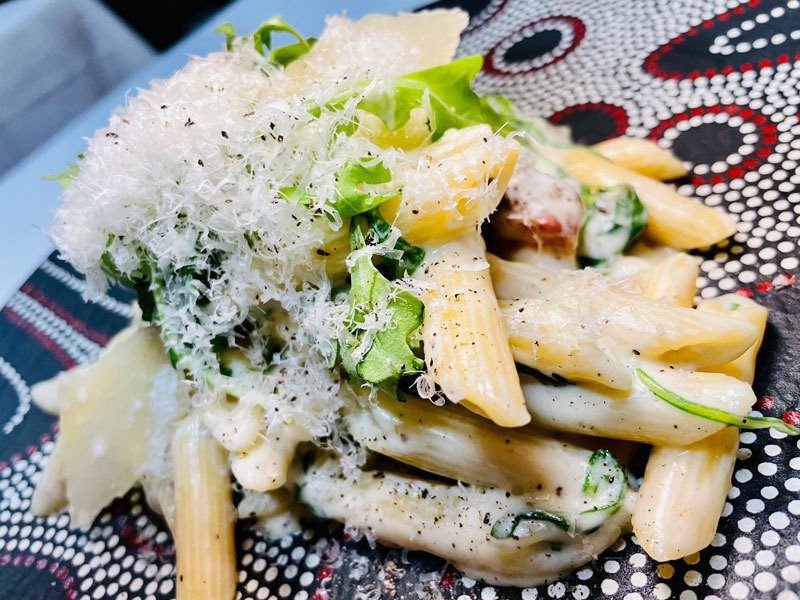
Directions:
STEP 1
Start by washing, peeling, and roughly cutting the arugula. Take the Speck Alto Adige or pancetta and cut it into strips.
STEP 2
In a non-stick pan, brown the Speck Alto Adige with a drizzle of extra virgin olive oil, until it becomes golden.
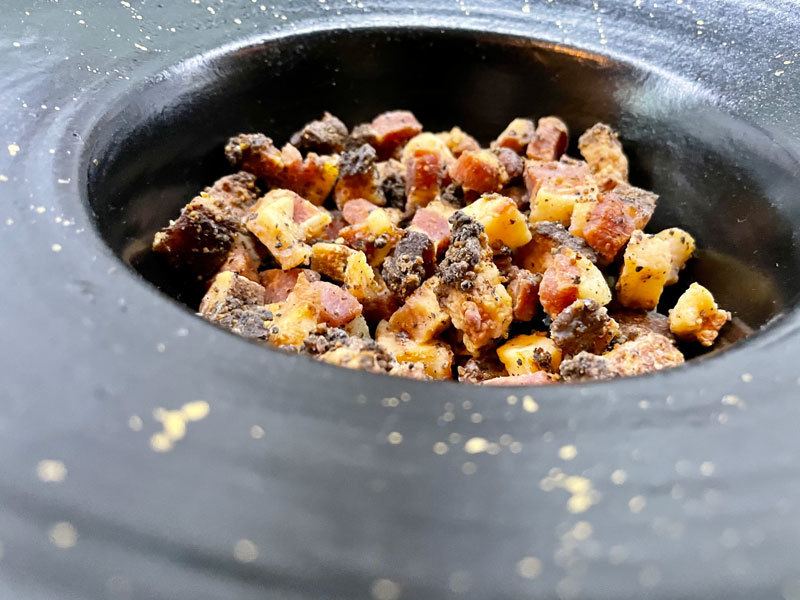
STEP 3
Cook the penne al dente in plenty of lightly salted water.
STEP 4
When the Speck Alto Adige is golden, add heavy cream in the pan along with 3 table spoons of Parmigiano Reggiano (preferably 36 Months) with the arugula and stir until everything is well mixed together. Lastly, season the mix with salt, add pepper and continue to stir while also simmering.

STEP 5
Add the penne to the pan and sauté them with the creamy mix until the pasta looks cooked. Turn off the heat when ready and serve the penne by adding the grated Parmigiano Reggiano 36 Months and finish by sprinkling some leaves of fresh arugula on top. Buon Appetito!
MAIN COURSE
Penne dei Poeti al Parmigiano Reggiano
-
10m
PREP
-
15m
COOK
-
4
SERVINGS
-
410
Calories
According to Chef Michele, “This dish was made famous by the Osteria dei Poeti – a popular osteria in Bologna. An “osteria” is a humble restaurant, where people gather to share simple, yet delicious meals. However, my first experienced with this dish dish was when I was a kid, sitting at the holiday table, celebrating the season with my family. I guess it became our go-to holiday staple because it is an easy dish to make for large gatherings. In our house, we always served it with generous portions of Parmigiano Reggiano. As I grew older, I realized they served essentially the same dish at my local osteria, but I would always ask for a little more Parmigiano Reggiano – because it gives it such a great consistency and rich flavor. I think it is a perfect dish for the holiday season because is simple, hearty, and reminds me of our family’s traditions”.
This delicious dish is brought to you by Parmigiano Reggiano and Barilla as part of a very special collaboration designed to share Italian holiday recipes with the American public. Want to learn more? Check out our blog post about the event and watch the recording where Chef Michele Casadei Massari and Barilla’s Executive Chef, Lorenzo Boni, show you how fun and easy it is to make these dishes at home.
Ingredients:
1 box of Barilla® Collezione Penne
4 oz Speck Alto Adige or pancetta
4 oz heavy cream
1 arugula bench
black kampot pepper
sea salt
1/2 cup of grated Parmigiano Reggiano (36 Months)
Look for the seal of authenticity.
For a better experience always use authentic Parmigiano Reggiano, made in Italy.

Hint:
Use Parmigiano Reggiano aged over 36 months to optimize flavor and texture.
MAIN COURSE
Penne dei Poeti al Parmigiano Reggiano
-
10m
PREP
-
15m
COOK
-
4
SERVINGS
-
410
Calories
According to Chef Michele, “This dish was made famous by the Osteria dei Poeti – a popular osteria in Bologna. An “osteria” is a humble restaurant, where people gather to share simple, yet delicious meals. However, my first experienced with this dish dish was when I was a kid, sitting at the holiday table, celebrating the season with my family. I guess it became our go-to holiday staple because it is an easy dish to make for large gatherings. In our house, we always served it with generous portions of Parmigiano Reggiano. As I grew older, I realized they served essentially the same dish at my local osteria, but I would always ask for a little more Parmigiano Reggiano – because it gives it such a great consistency and rich flavor. I think it is a perfect dish for the holiday season because is simple, hearty, and reminds me of our family’s traditions”.
This delicious dish is brought to you by Parmigiano Reggiano and Barilla as part of a very special collaboration designed to share Italian holiday recipes with the American public. Want to learn more? Check out our blog post about the event and watch the recording where Chef Michele Casadei Massari and Barilla’s Executive Chef, Lorenzo Boni, show you how fun and easy it is to make these dishes at home.
Directions:
STEP 1
Start by washing, peeling, and roughly cutting the arugula. Take the Speck Alto Adige or pancetta and cut it into strips.
STEP 2
In a non-stick pan, brown the Speck Alto Adige with a drizzle of extra virgin olive oil, until it becomes golden.

STEP 3
Cook the penne al dente in plenty of lightly salted water.
STEP 4
When the Speck Alto Adige is golden, add heavy cream in the pan along with 3 table spoons of Parmigiano Reggiano (preferably 36 Months) with the arugula and stir until everything is well mixed together. Lastly, season the mix with salt, add pepper and continue to stir while also simmering.

STEP 5
Add the penne to the pan and sauté them with the creamy mix until the pasta looks cooked. Turn off the heat when ready and serve the penne by adding the grated Parmigiano Reggiano 36 Months and finish by sprinkling some leaves of fresh arugula on top. Buon Appetito!
Ingredients:
1 box of Barilla® Collezione Penne
4 oz Speck Alto Adige or pancetta
4 oz heavy cream
1 arugula bench
black kampot pepper
sea salt
1/2 cup of grated Parmigiano Reggiano (36 Months)
Look for the seal of authenticity.
For a better experience always use authentic Parmigiano Reggiano, made in Italy.

Hint:
Use Parmigiano Reggiano aged over 36 months to optimize flavor and texture.
Where to buy:
Complete your meal
SUBMIT YOUR RECIPES
Become a superstar!
Every month our curatorial team will review the recipes that have been submitted. If yours is selected we will send you a nice gift and will feature the recipe on our website (along with your photo and bio), and we’ll also post it on our Social Media platforms.

